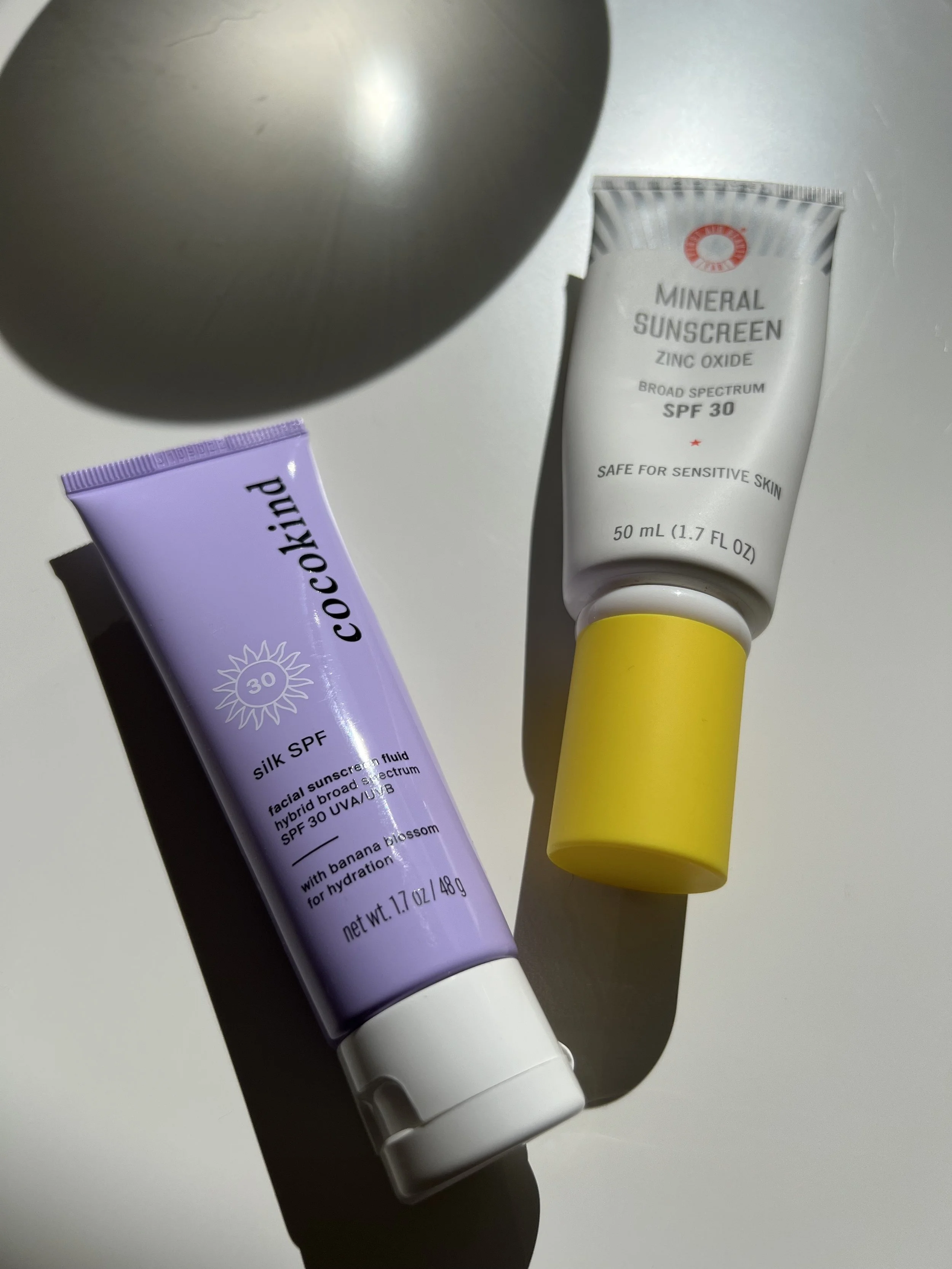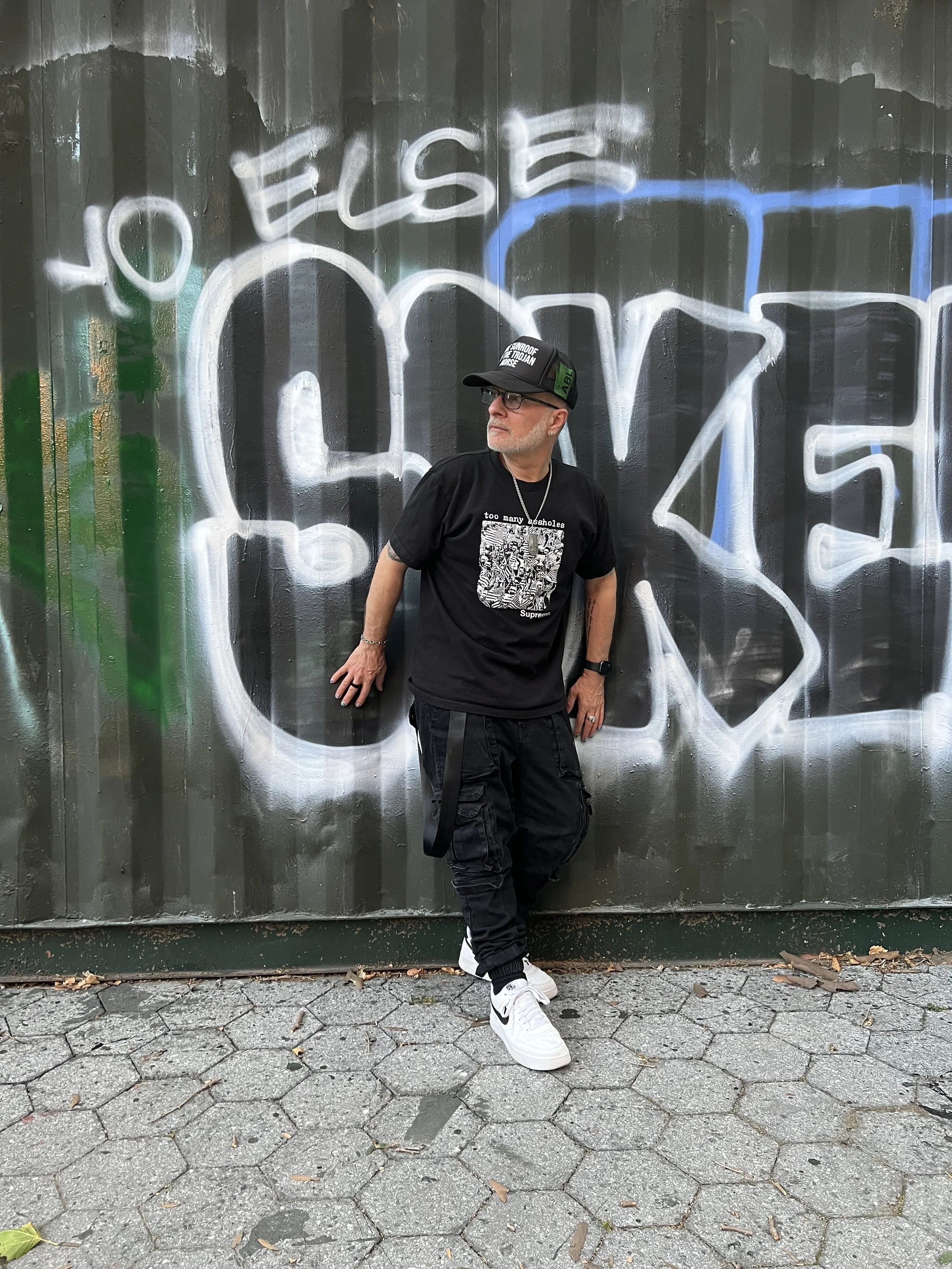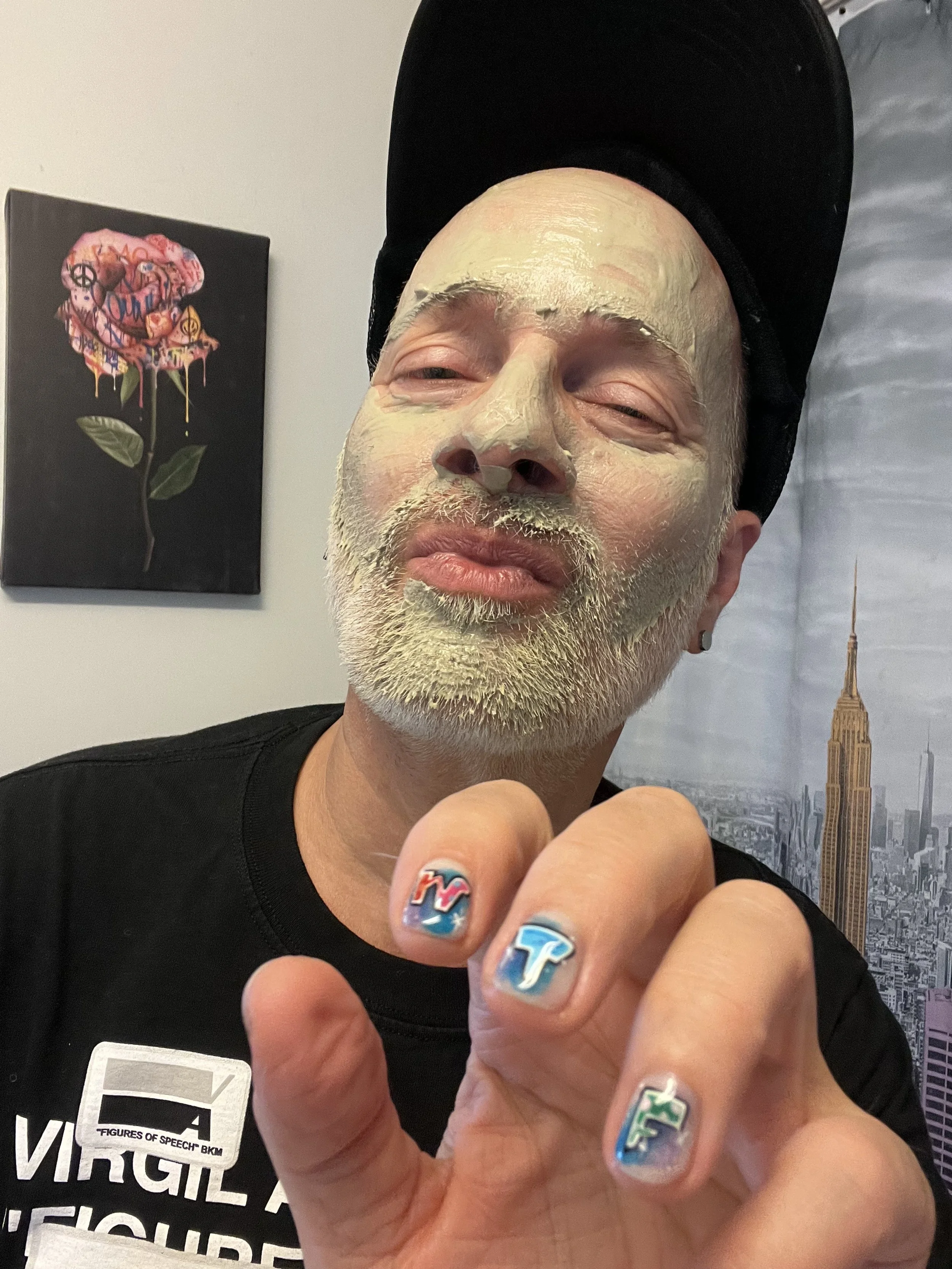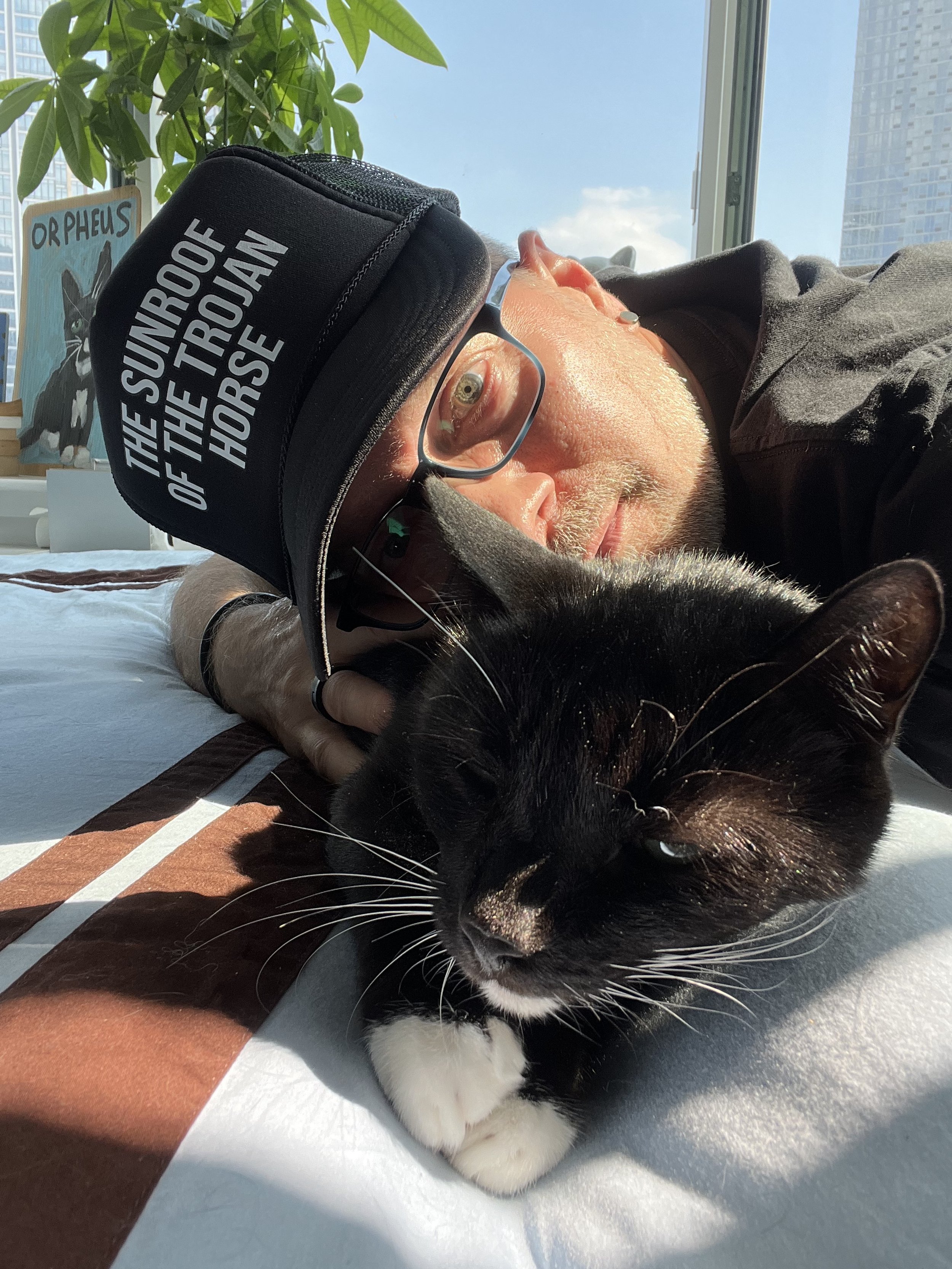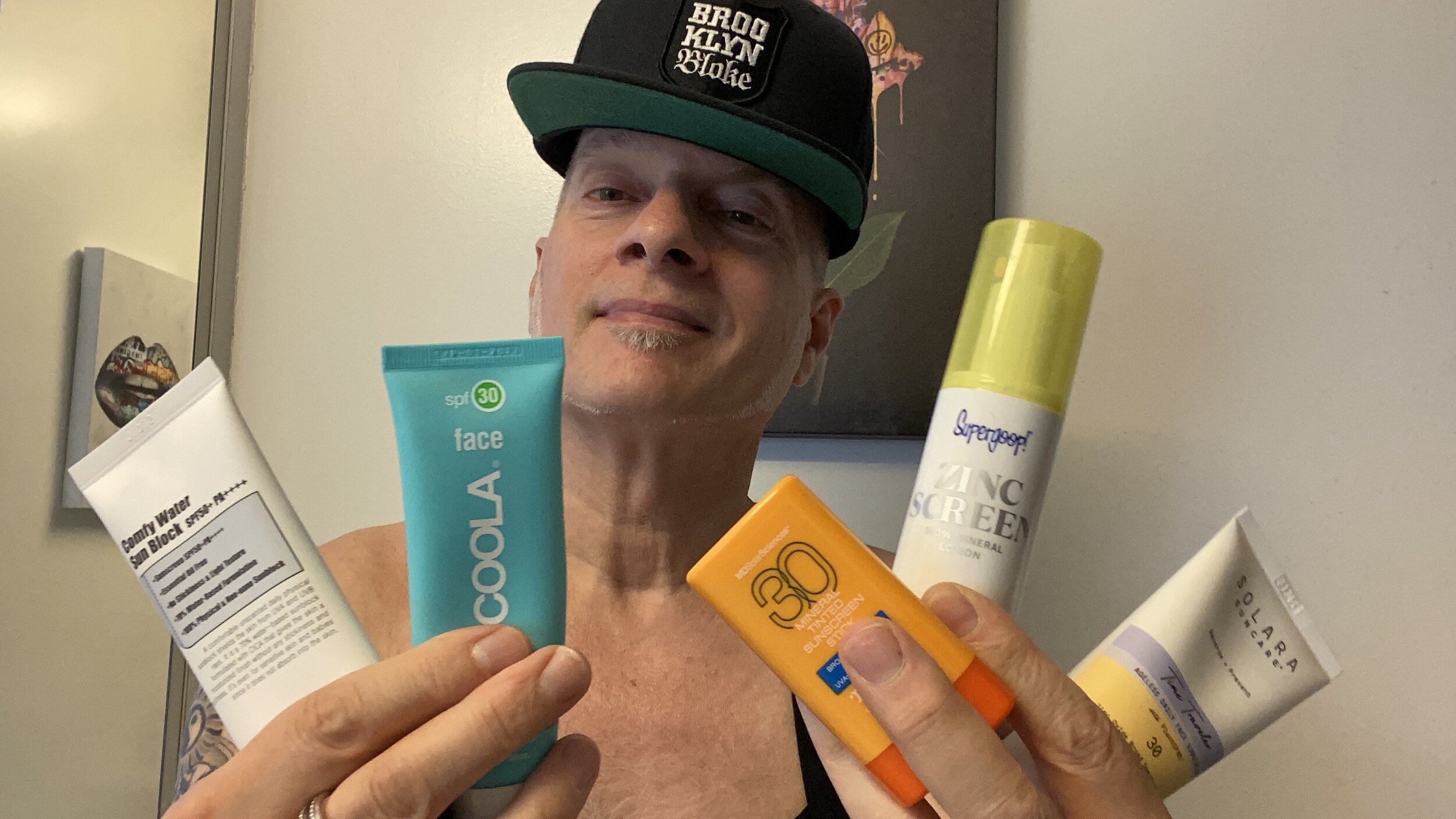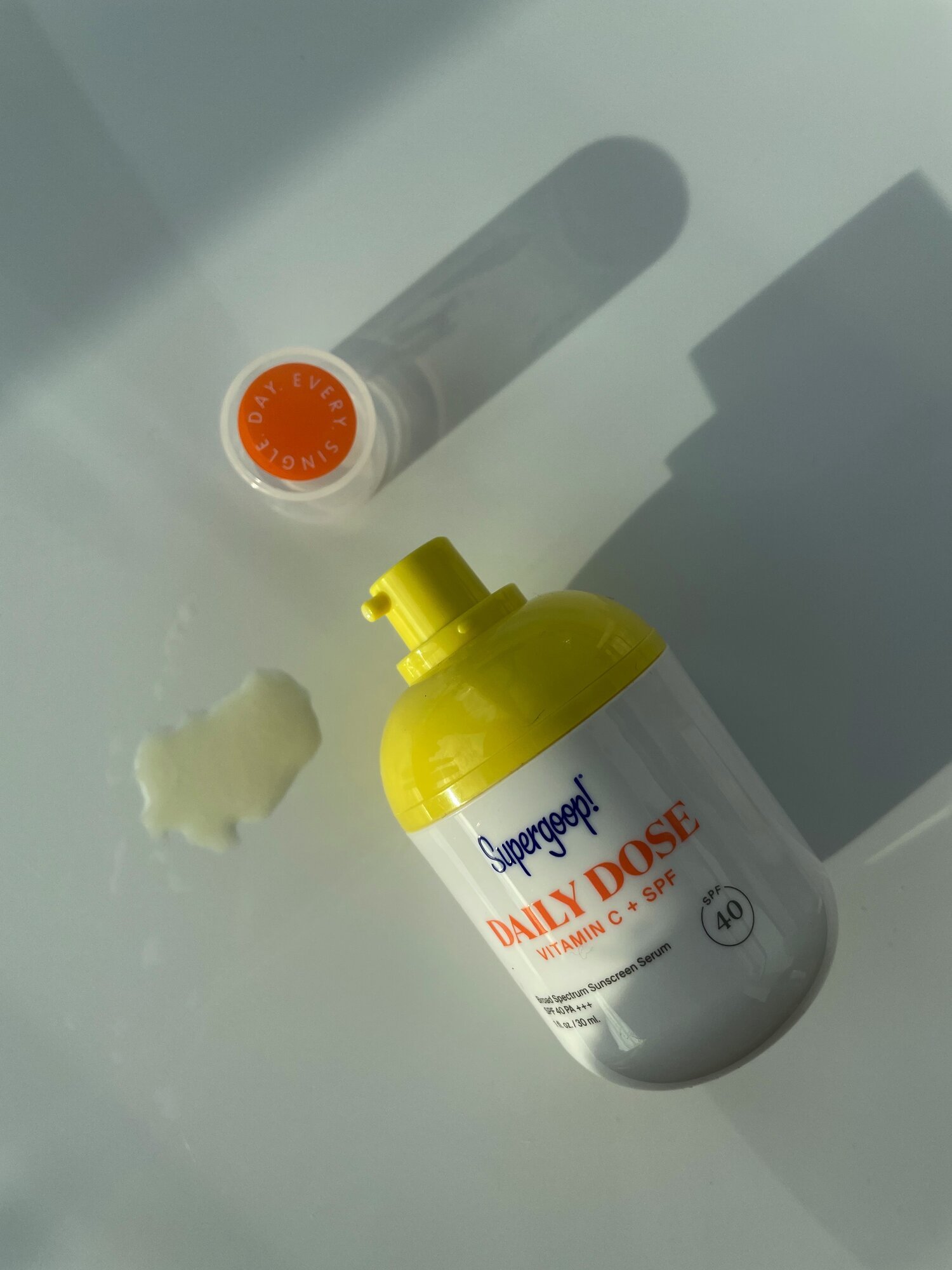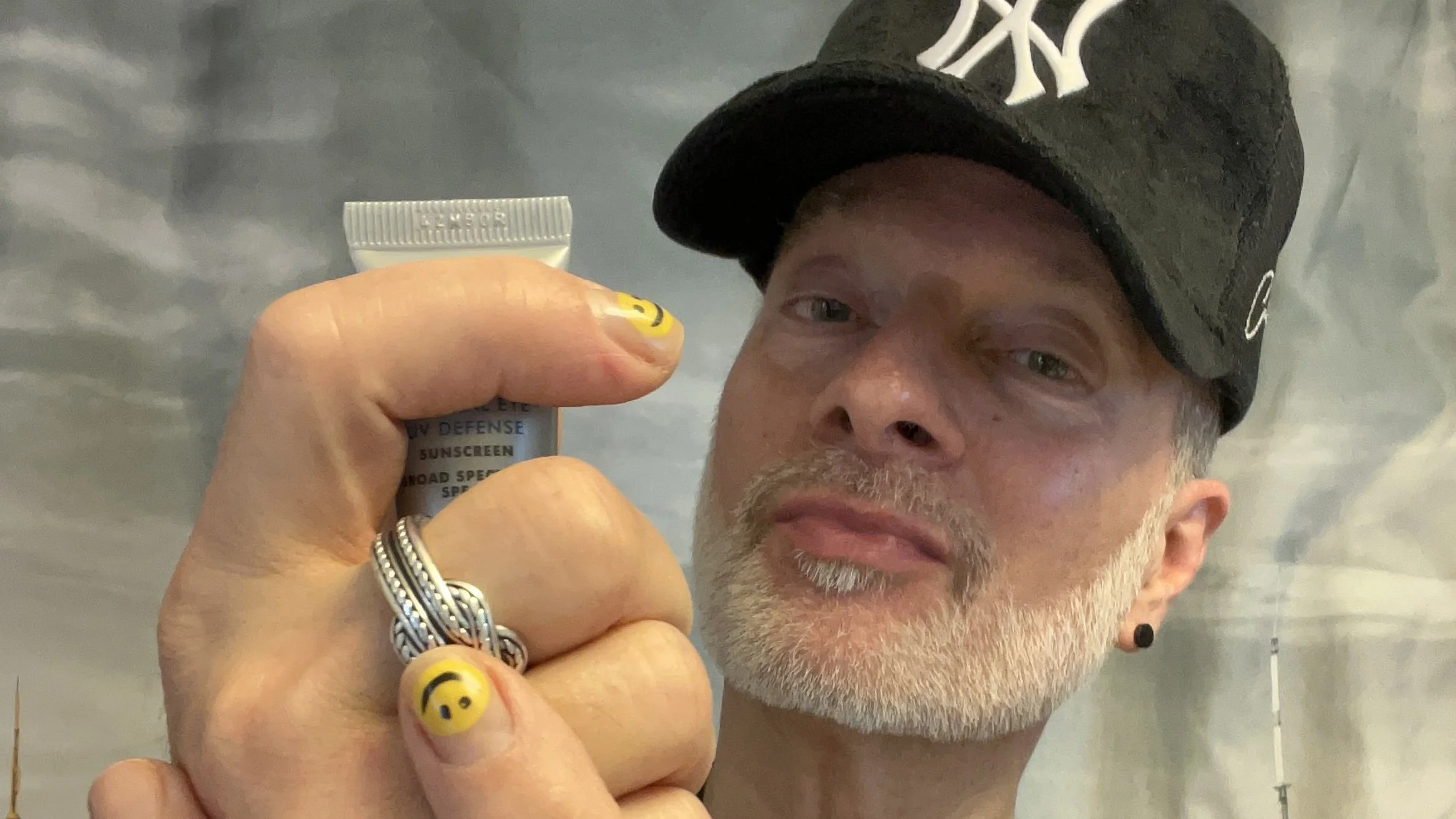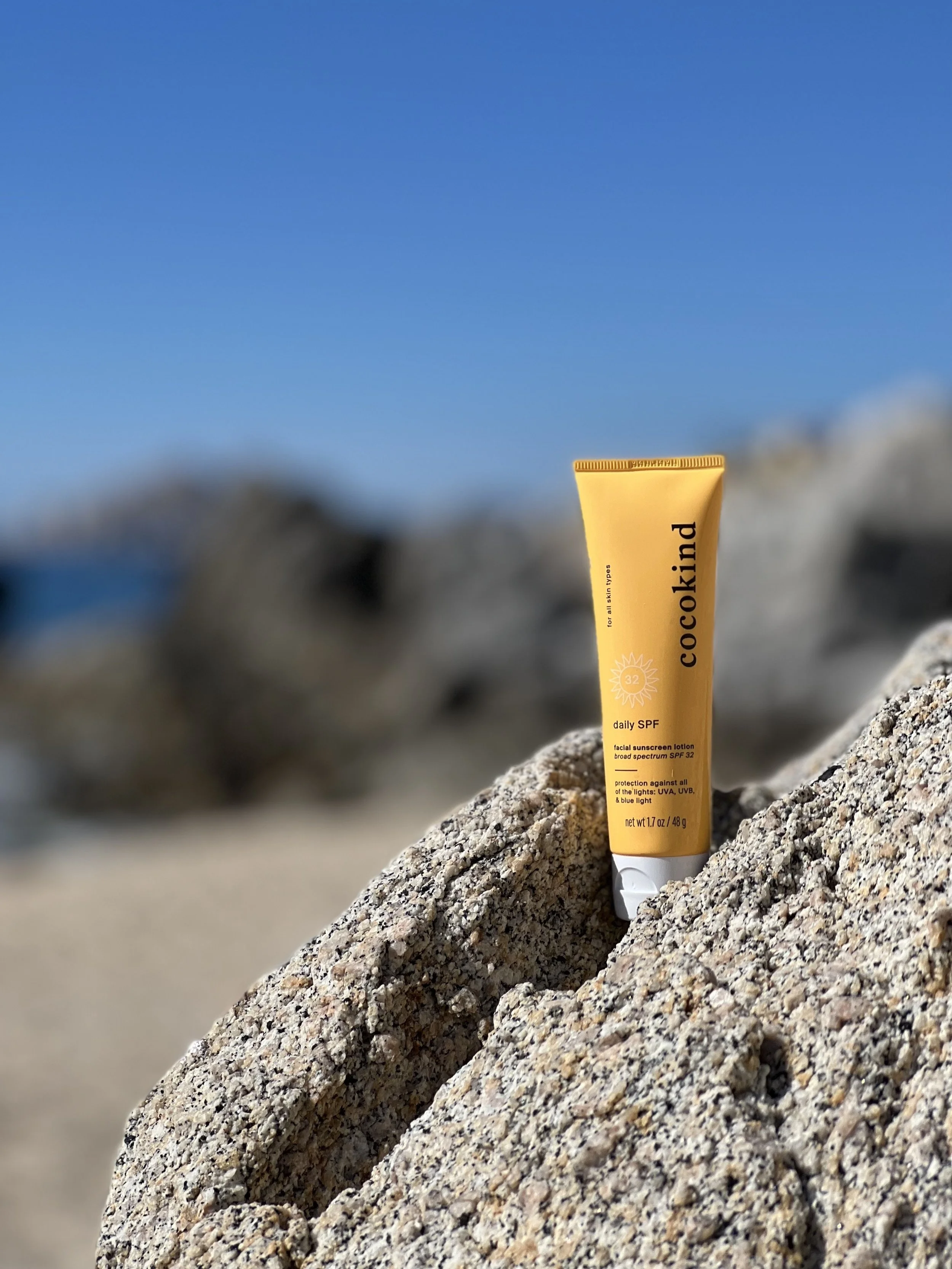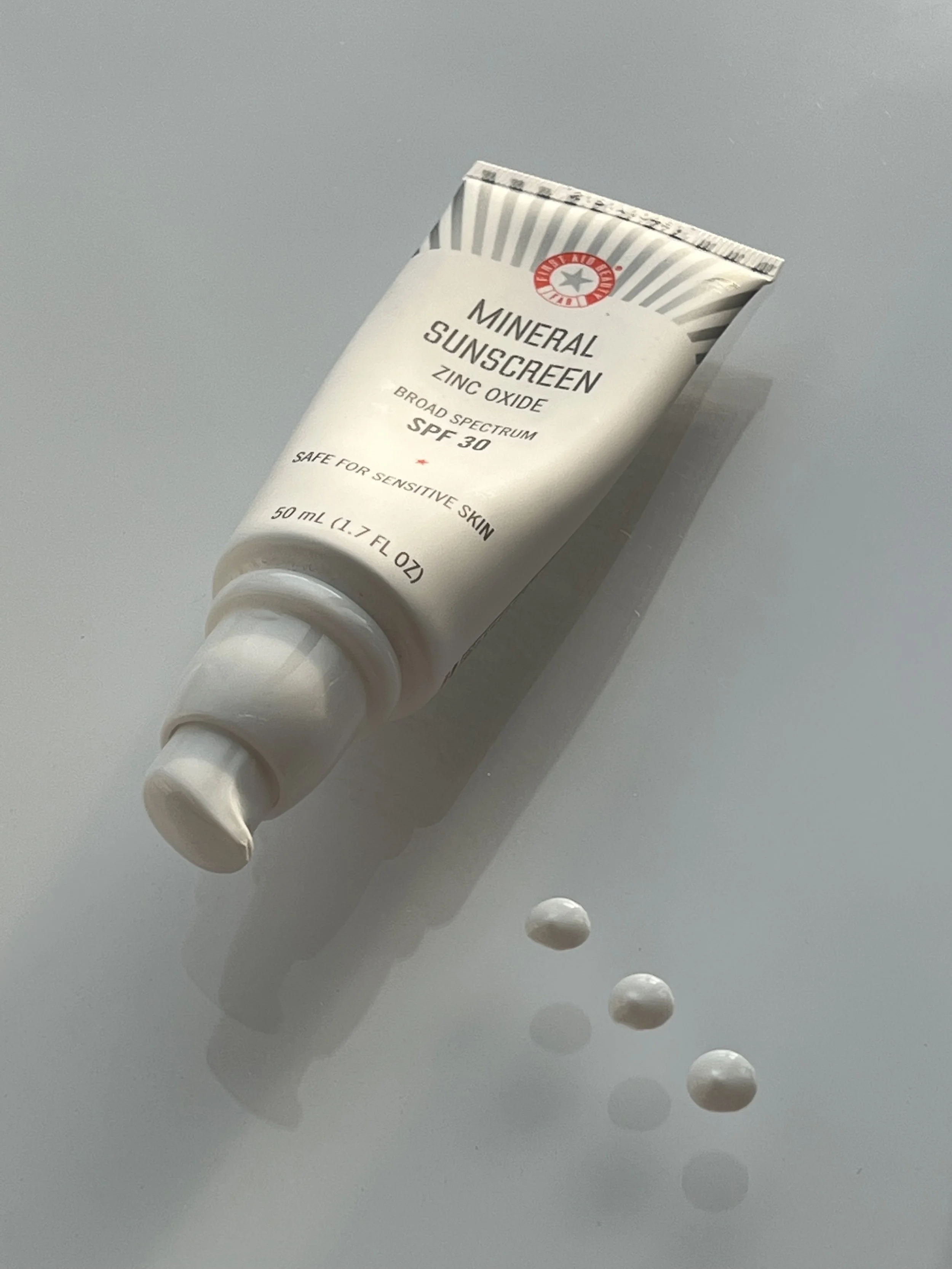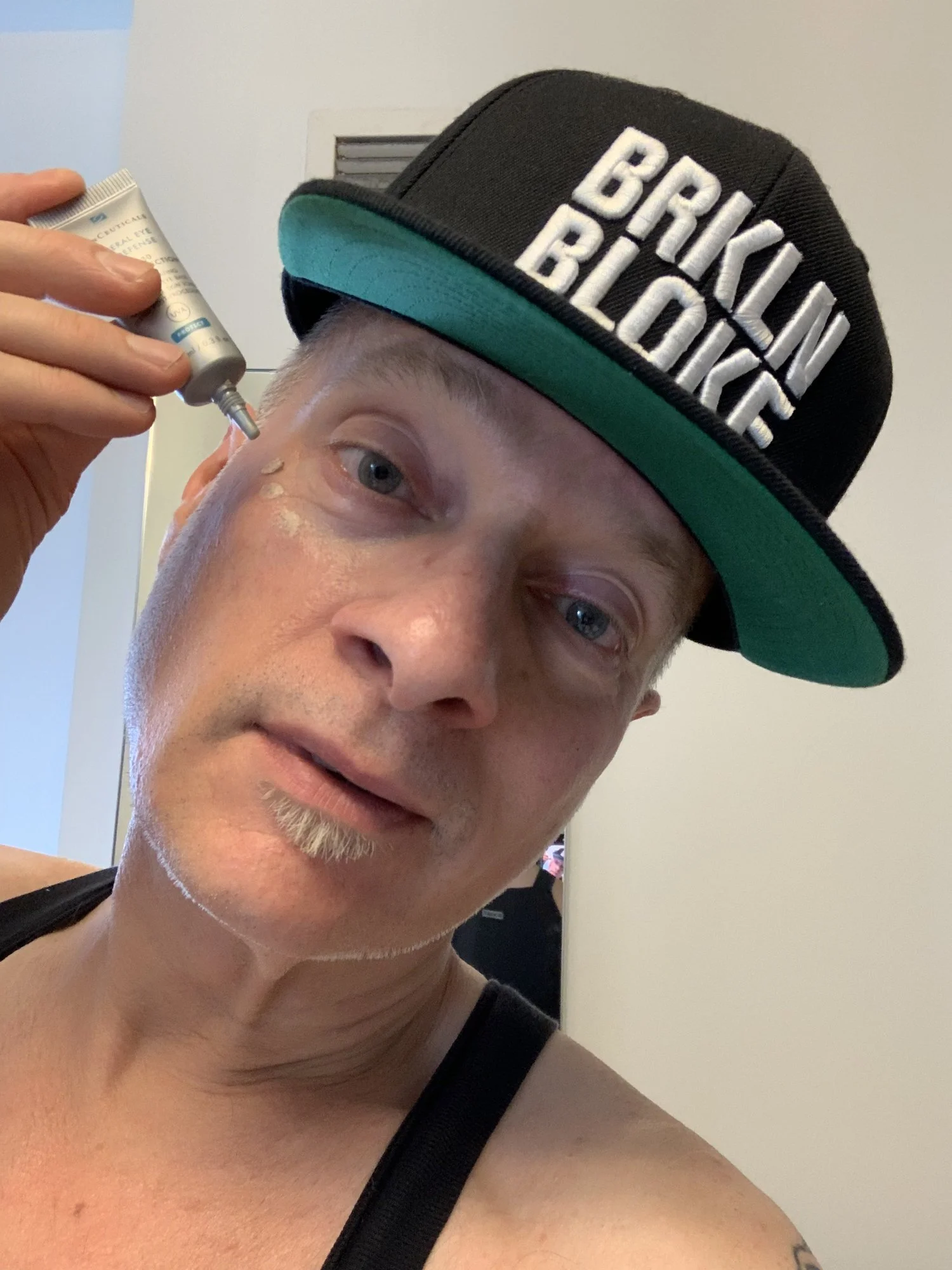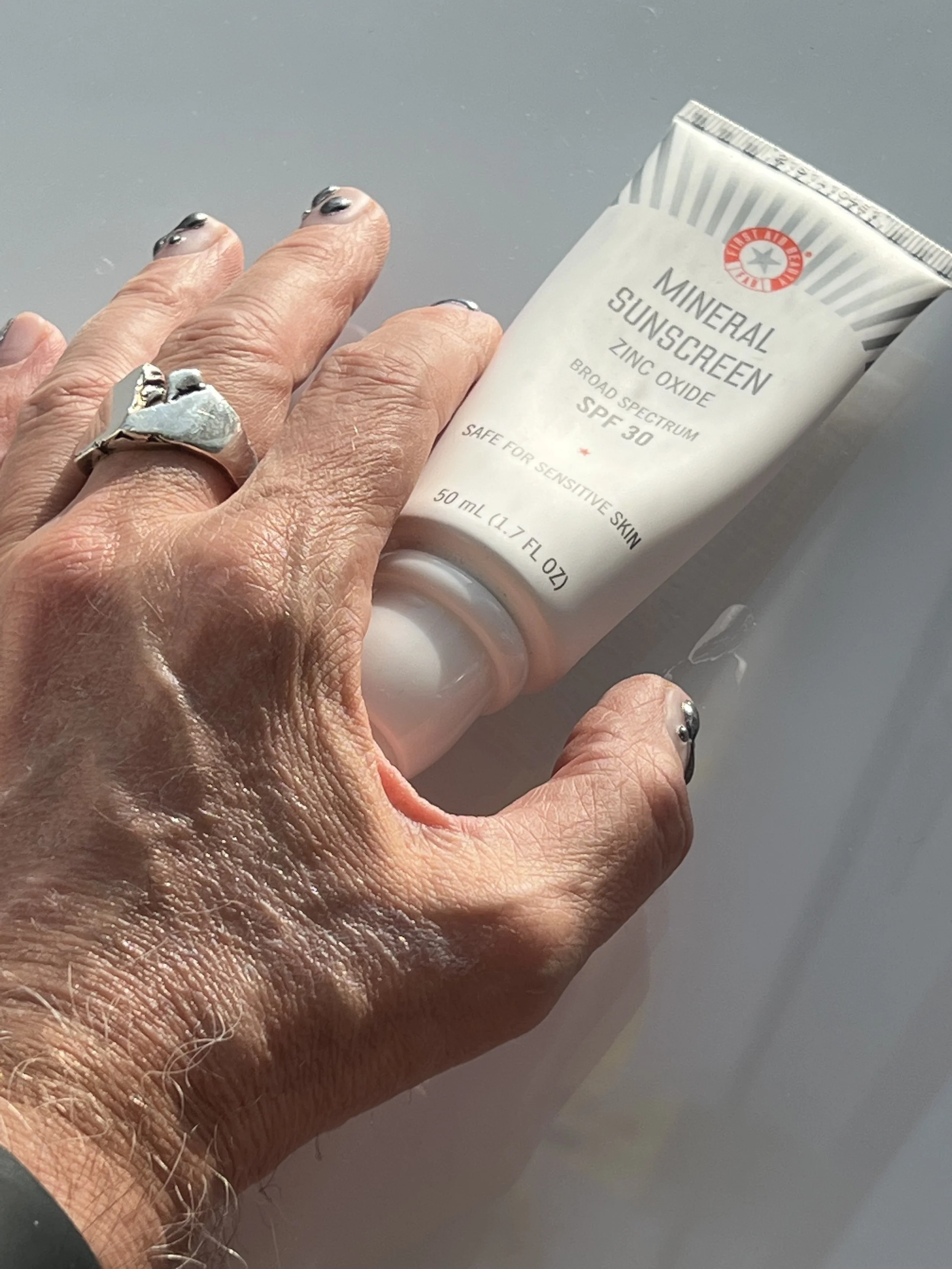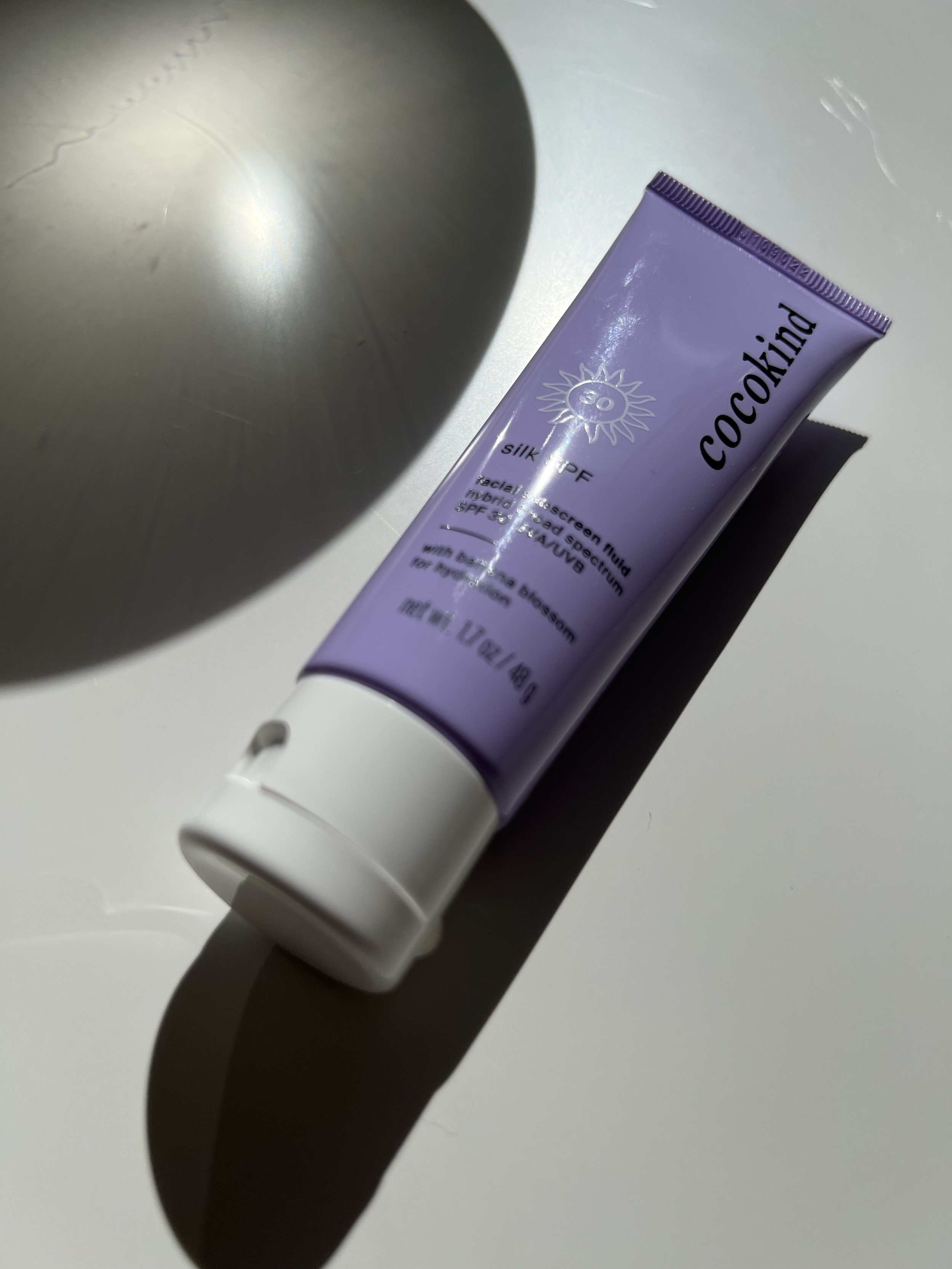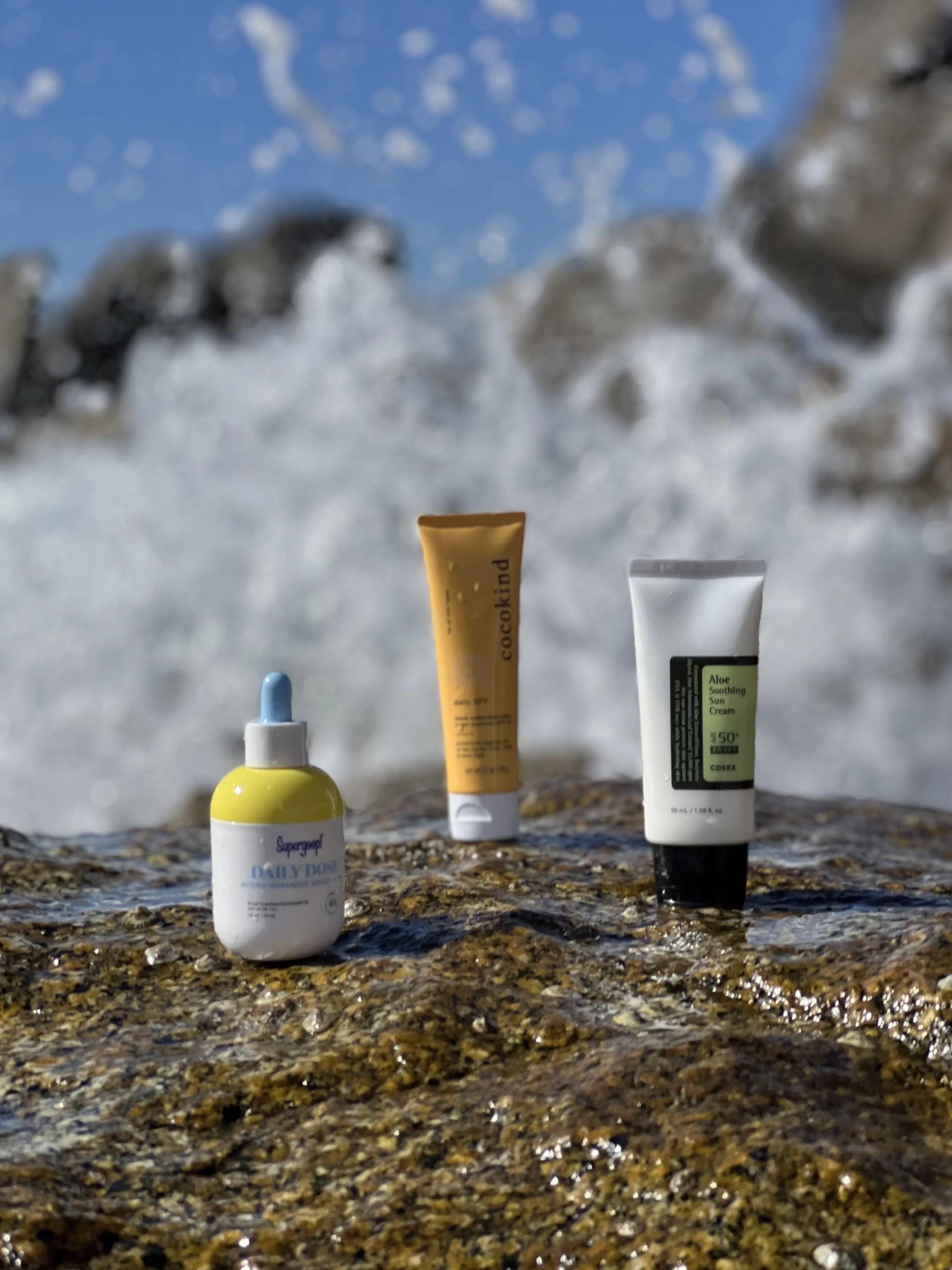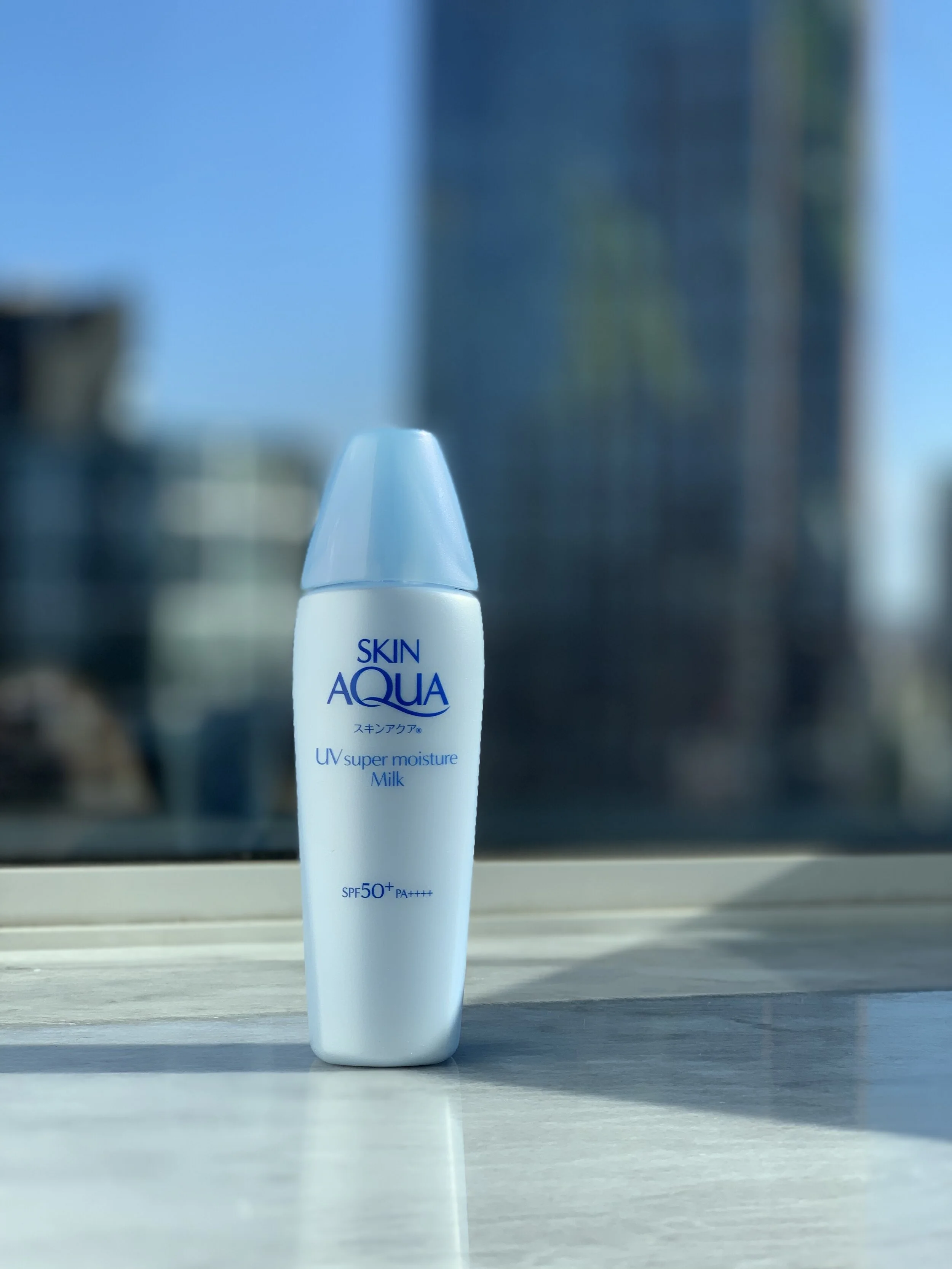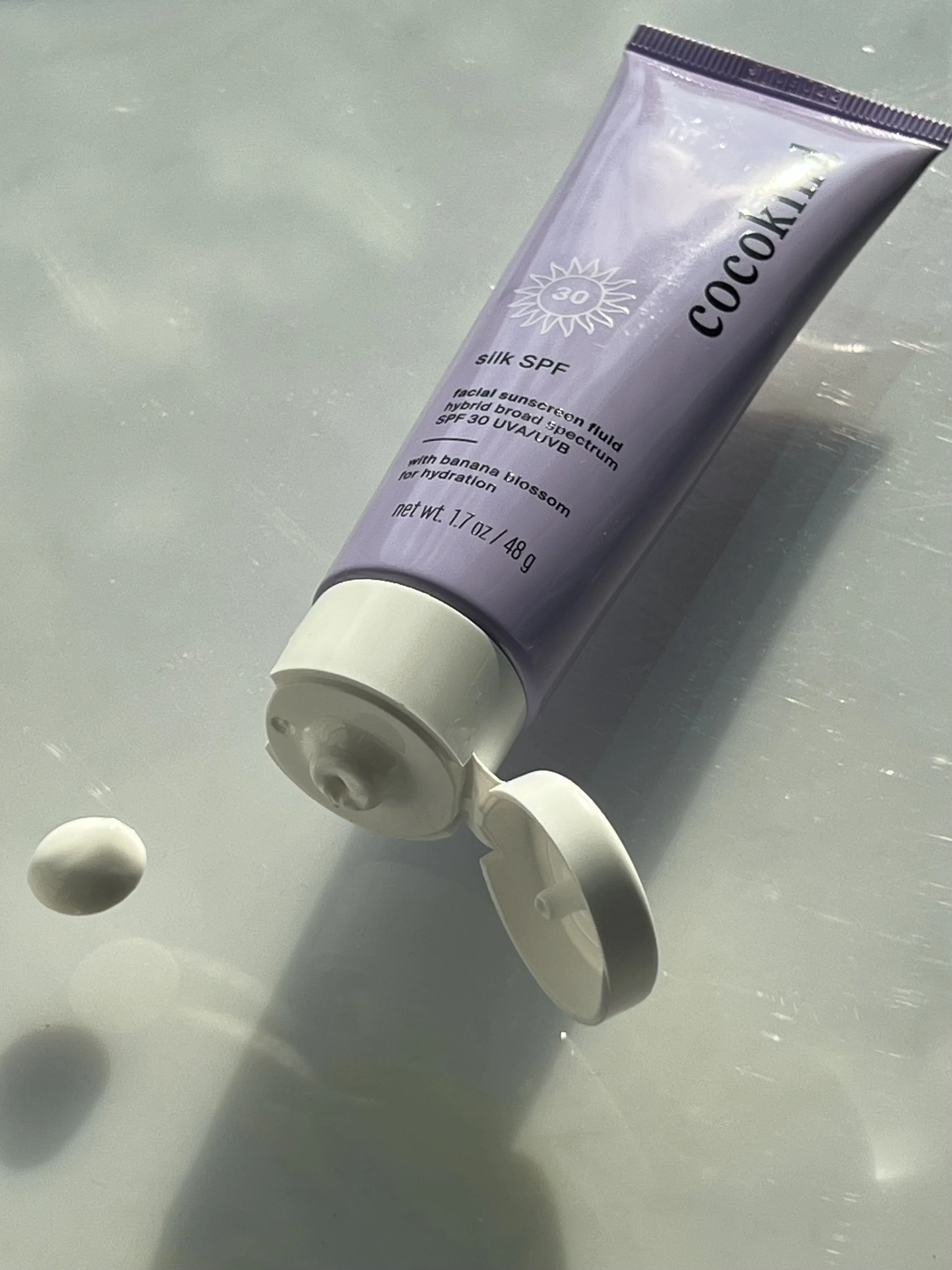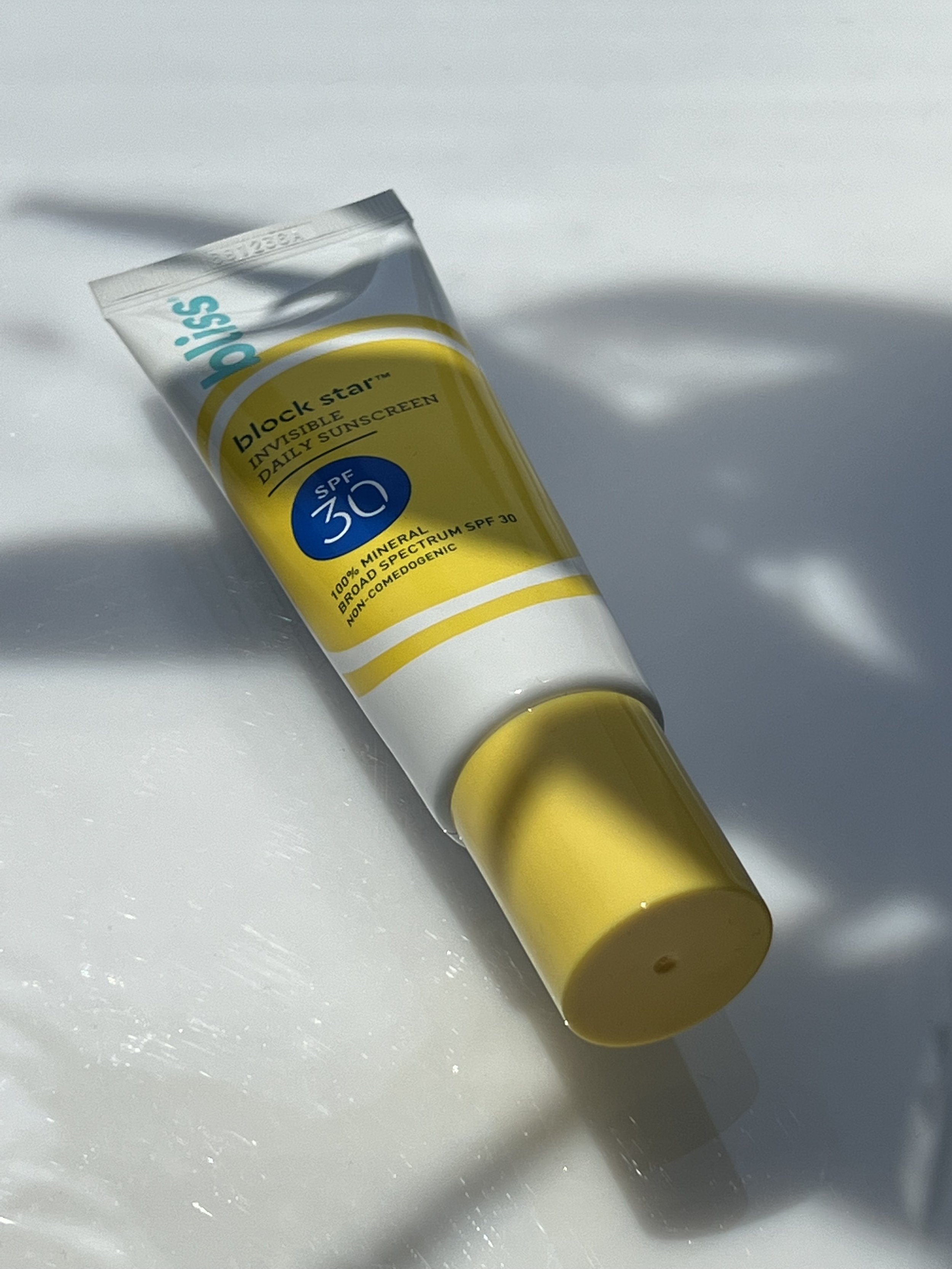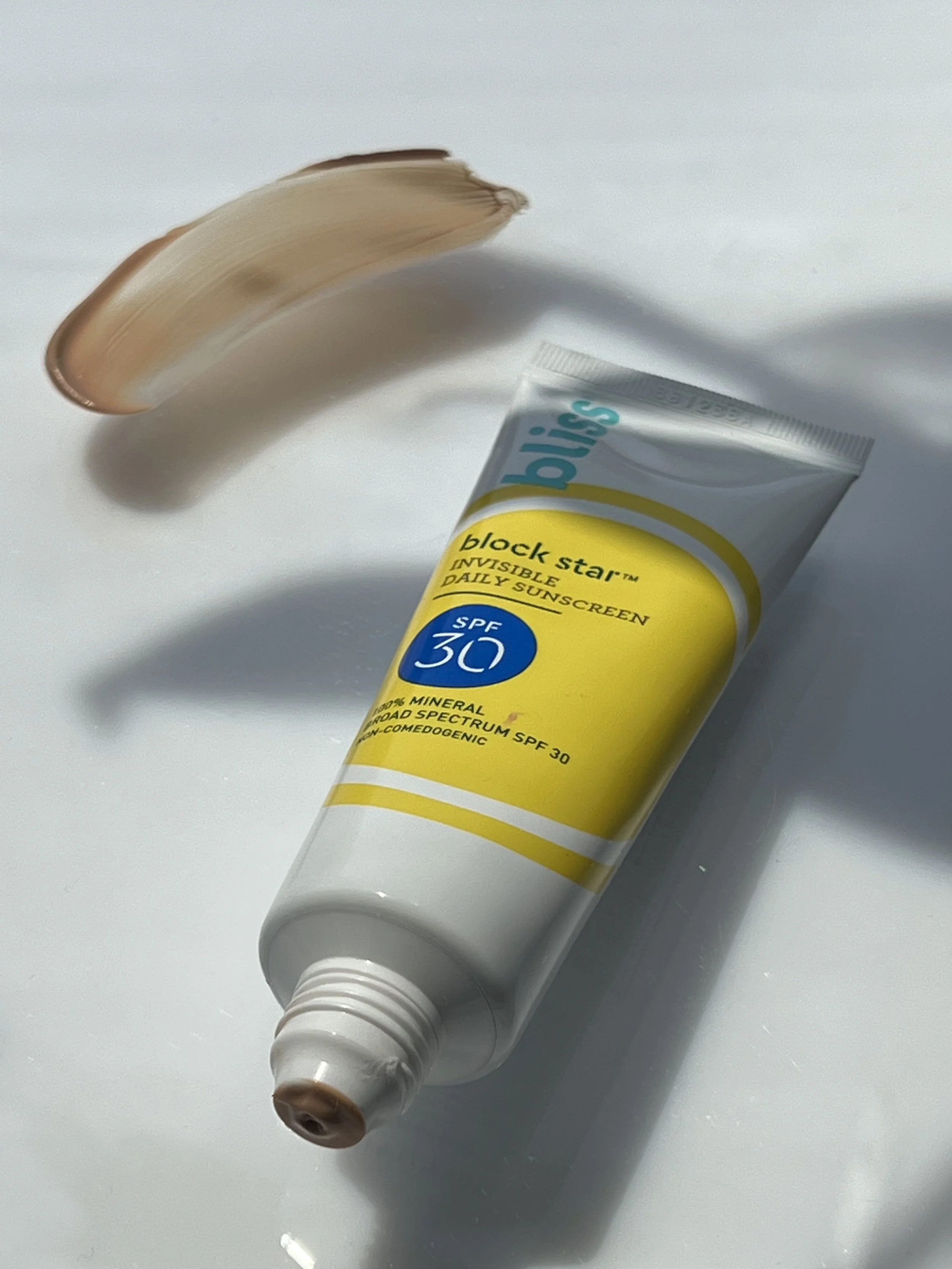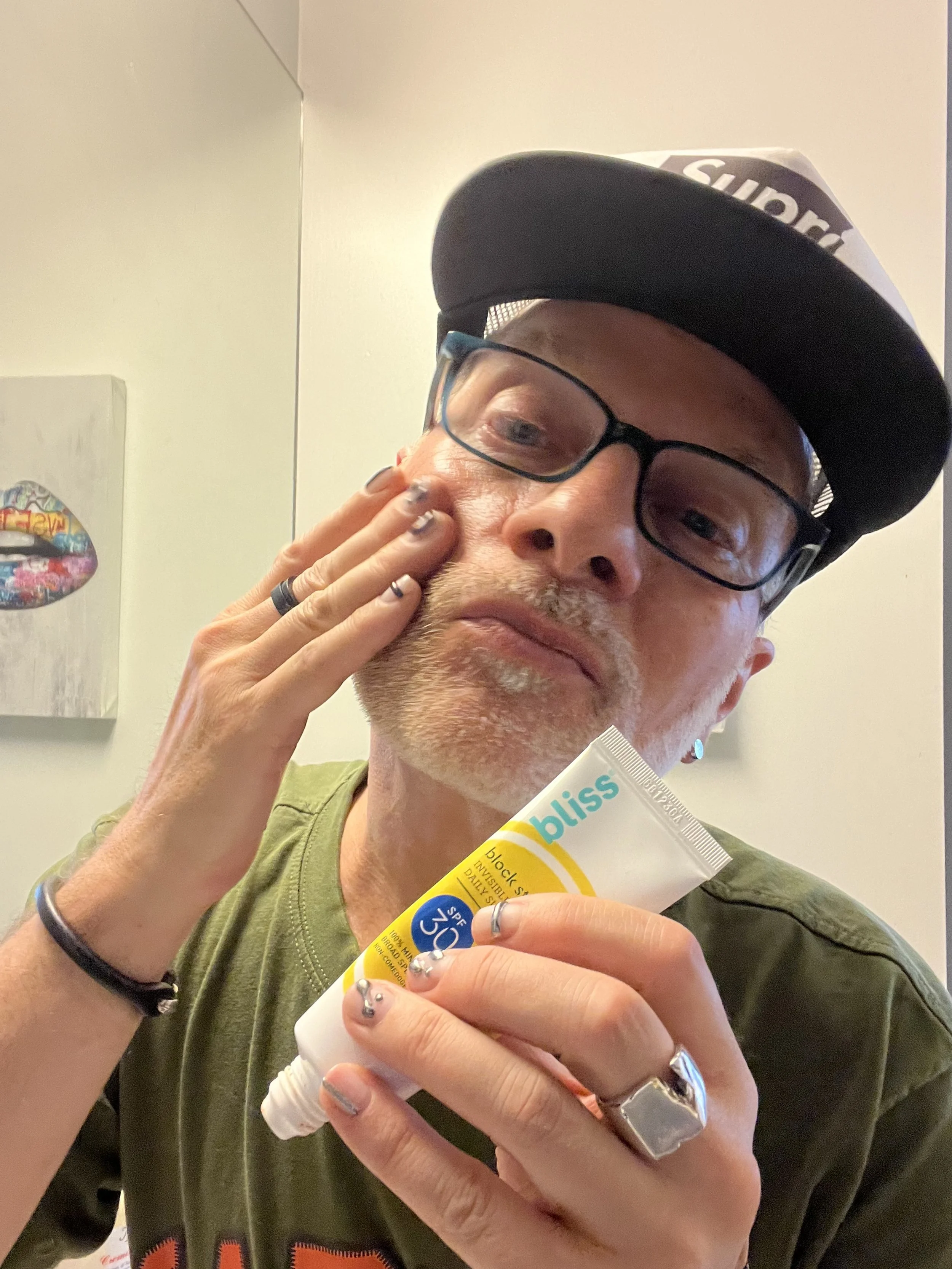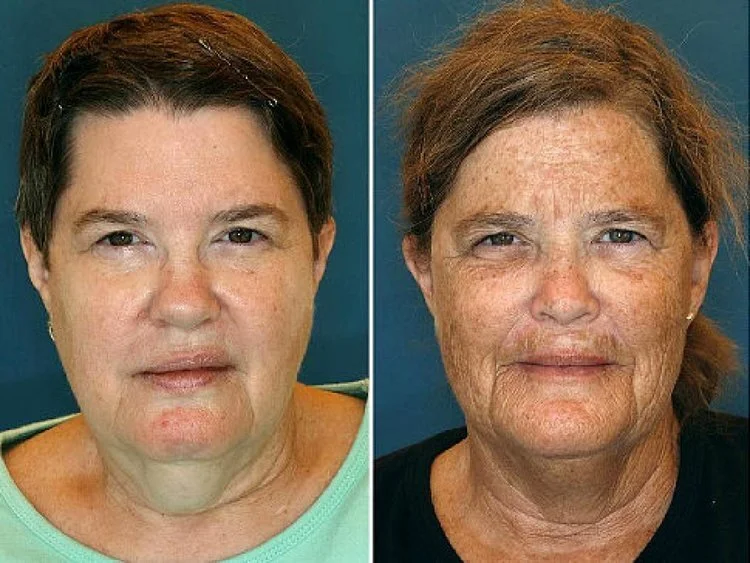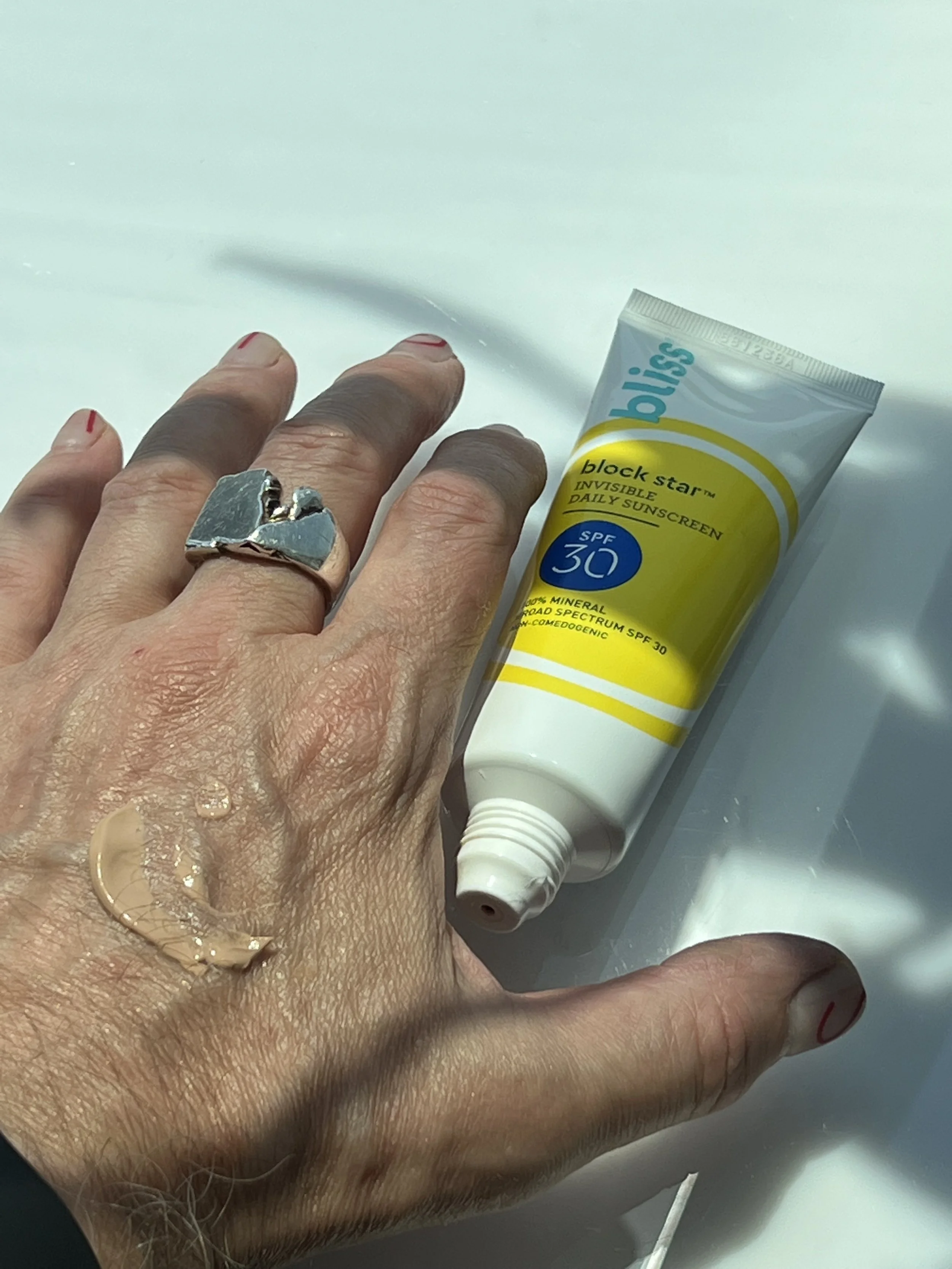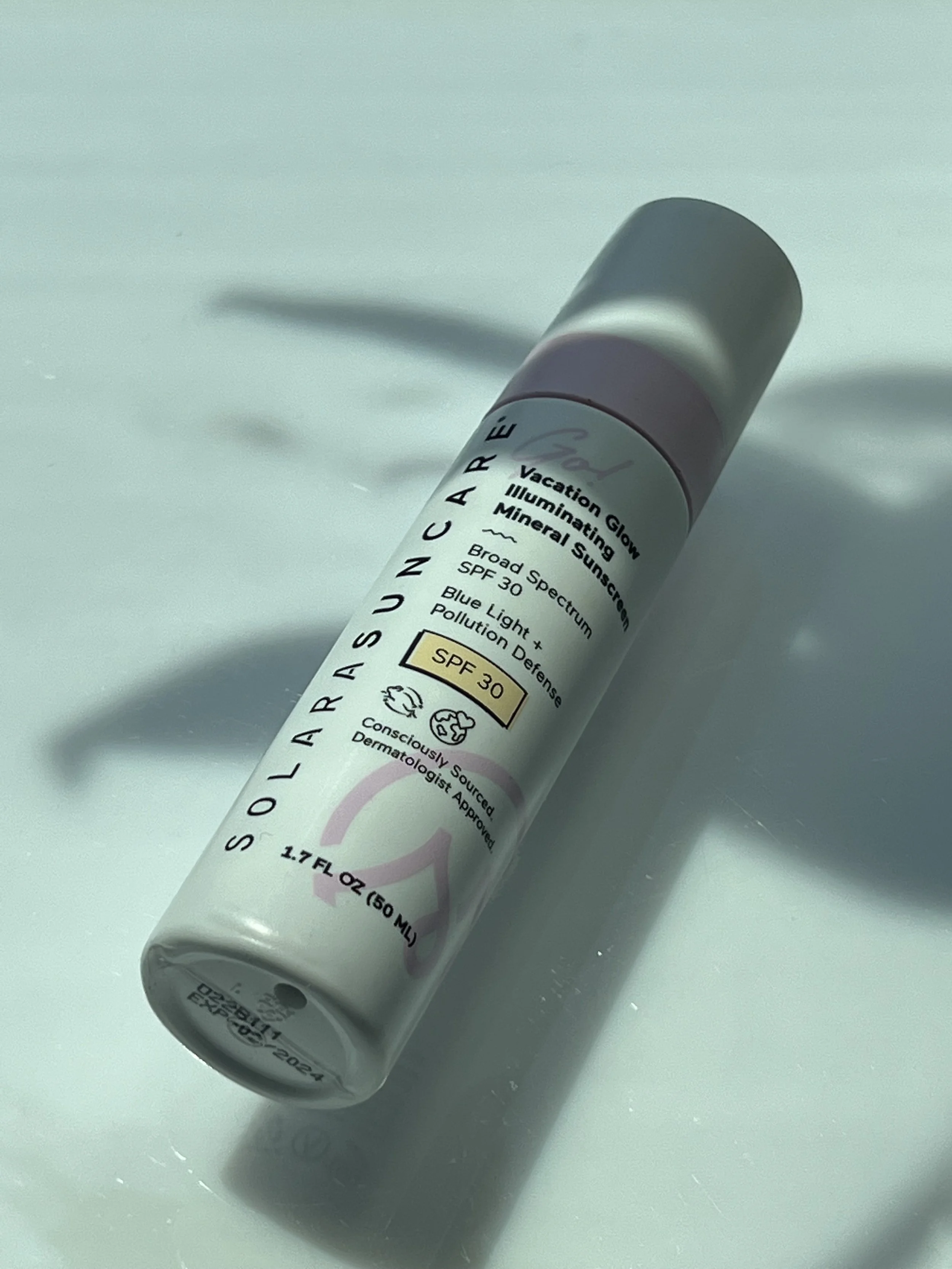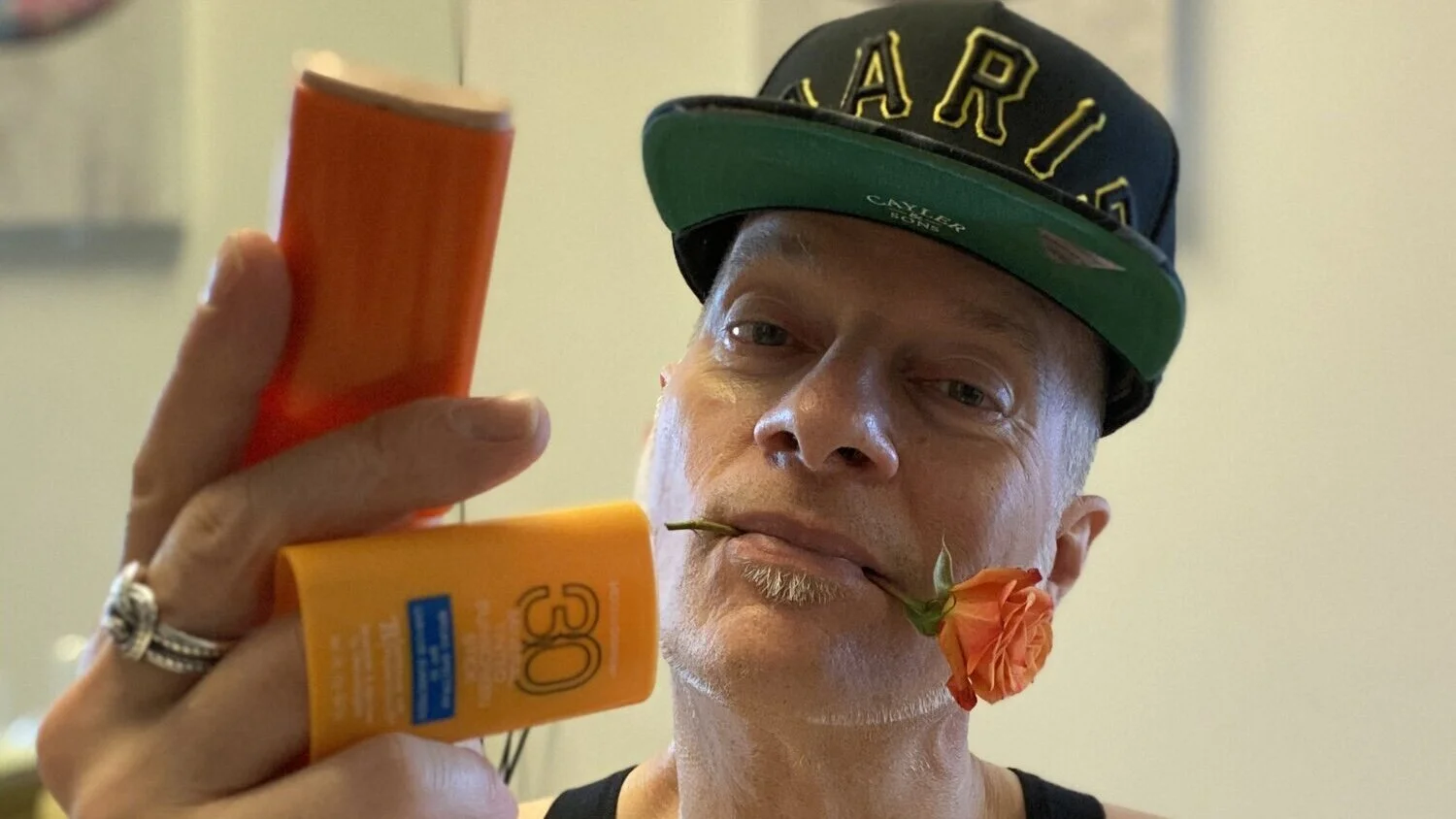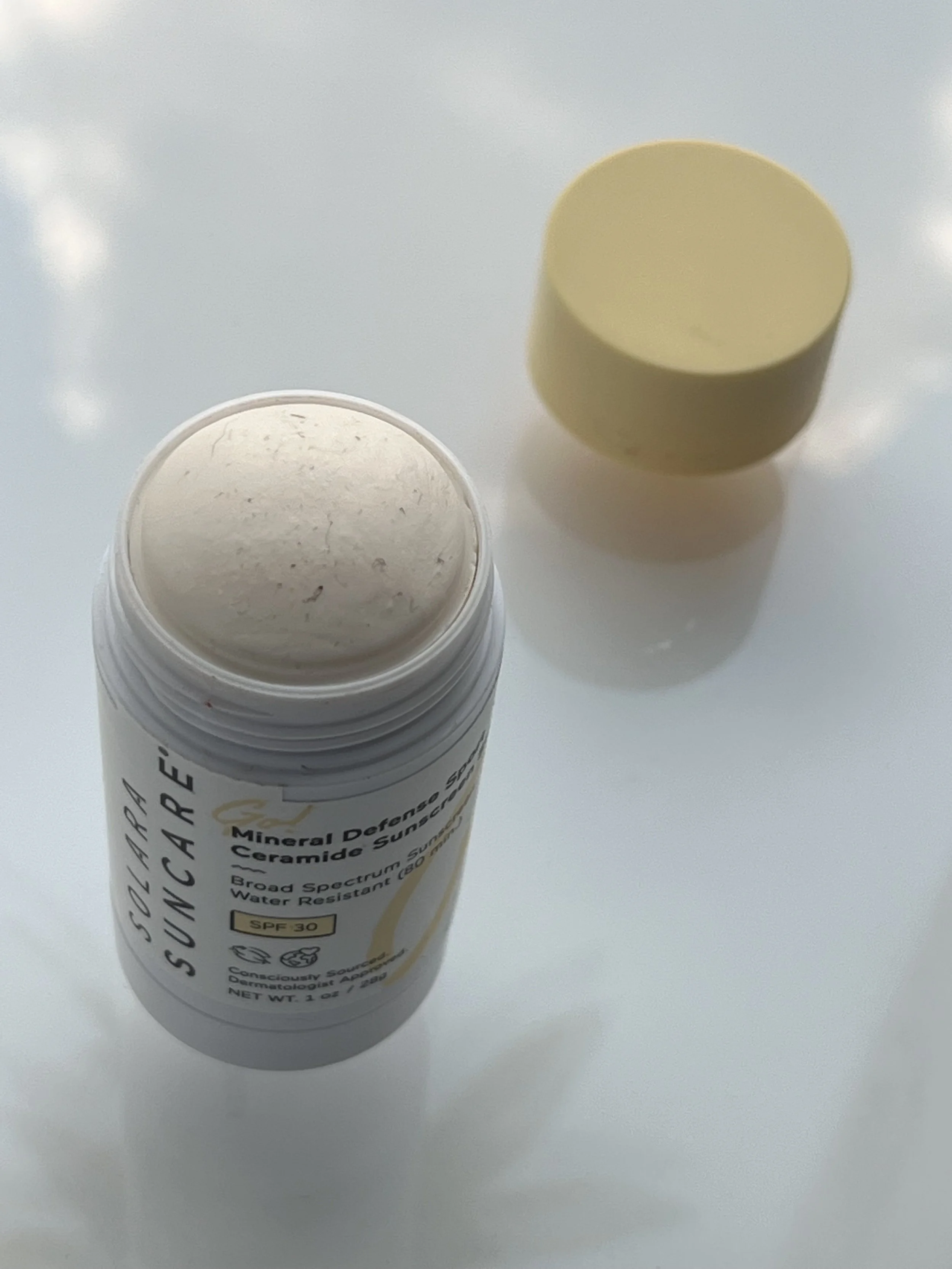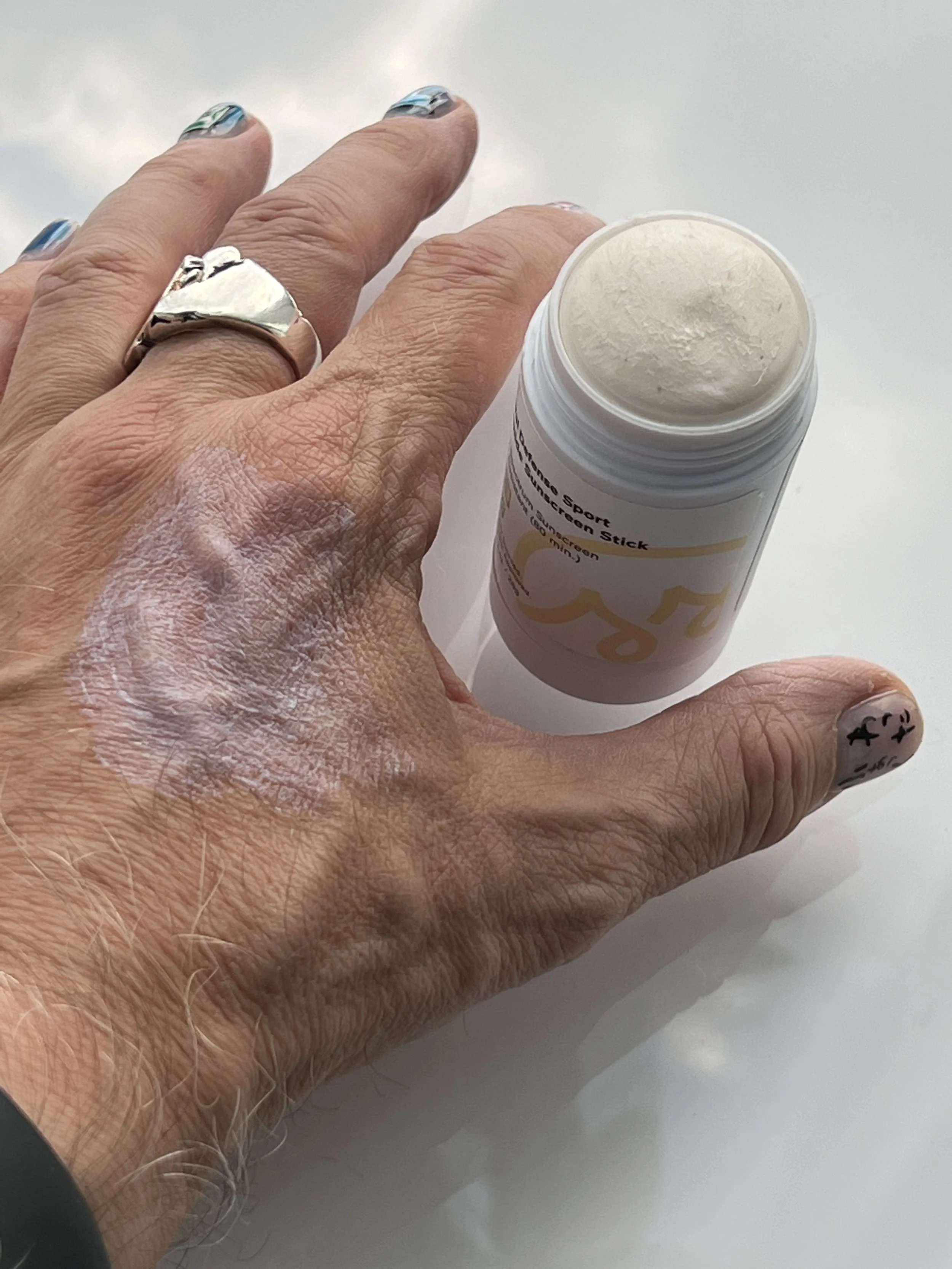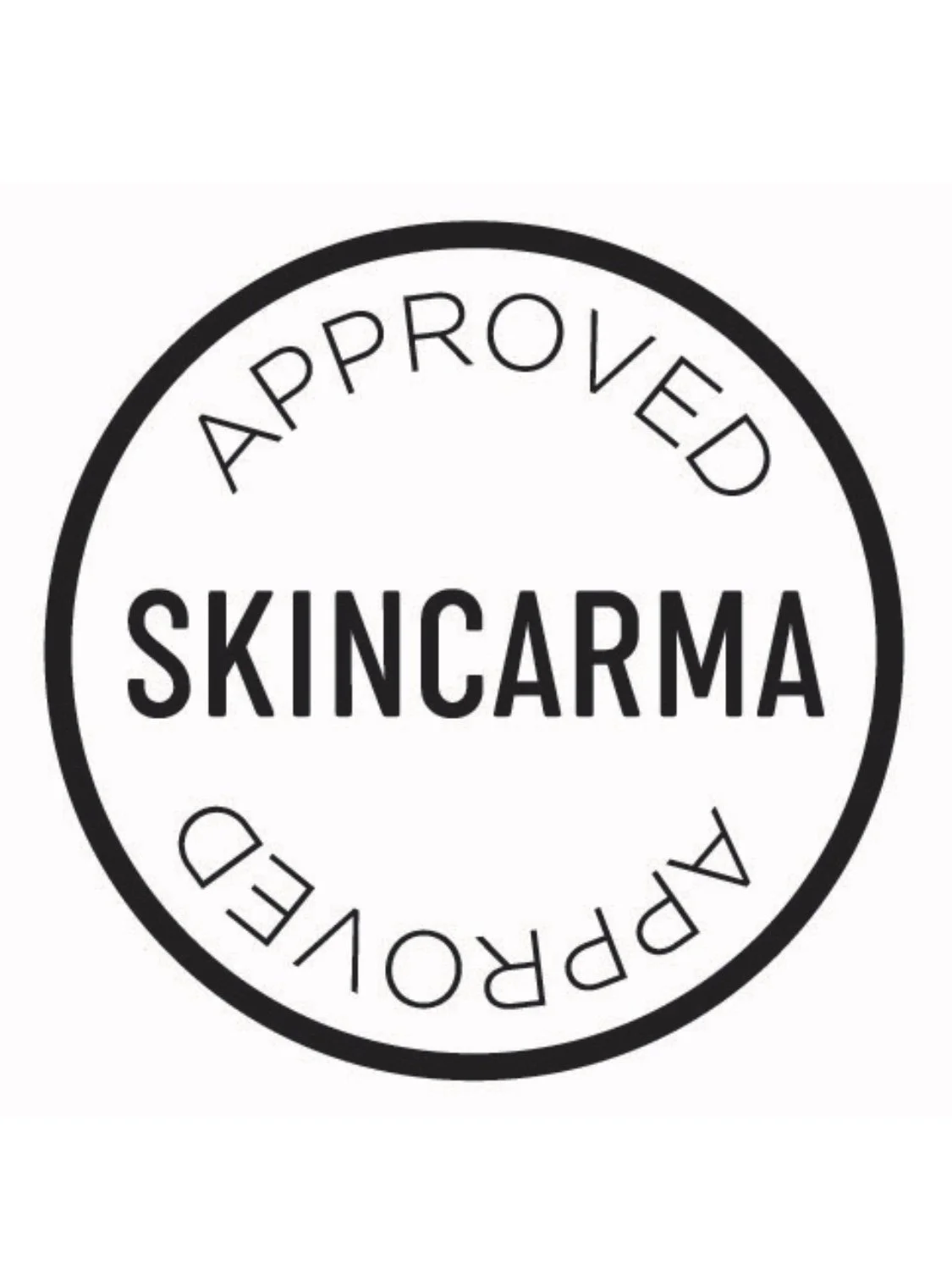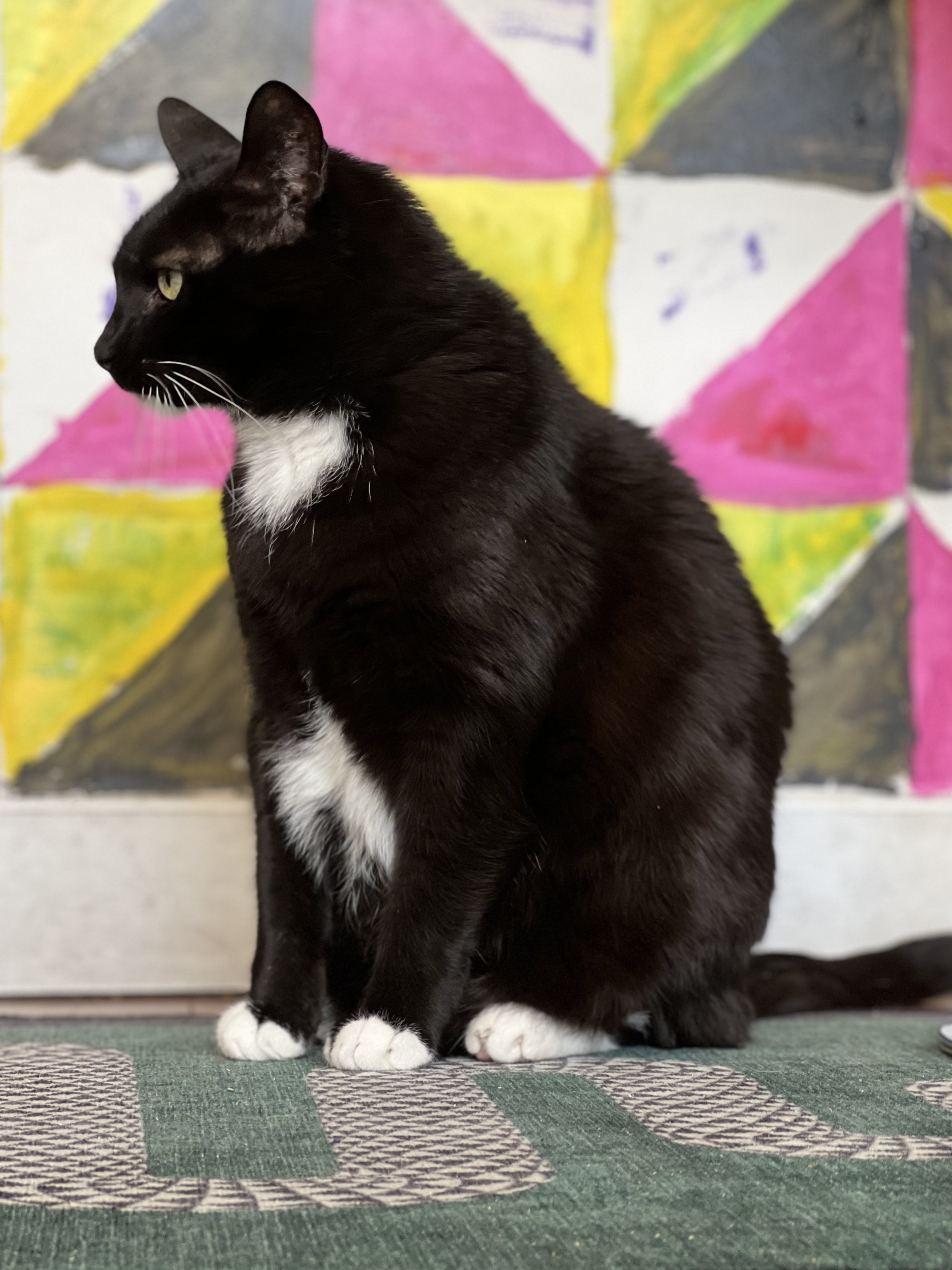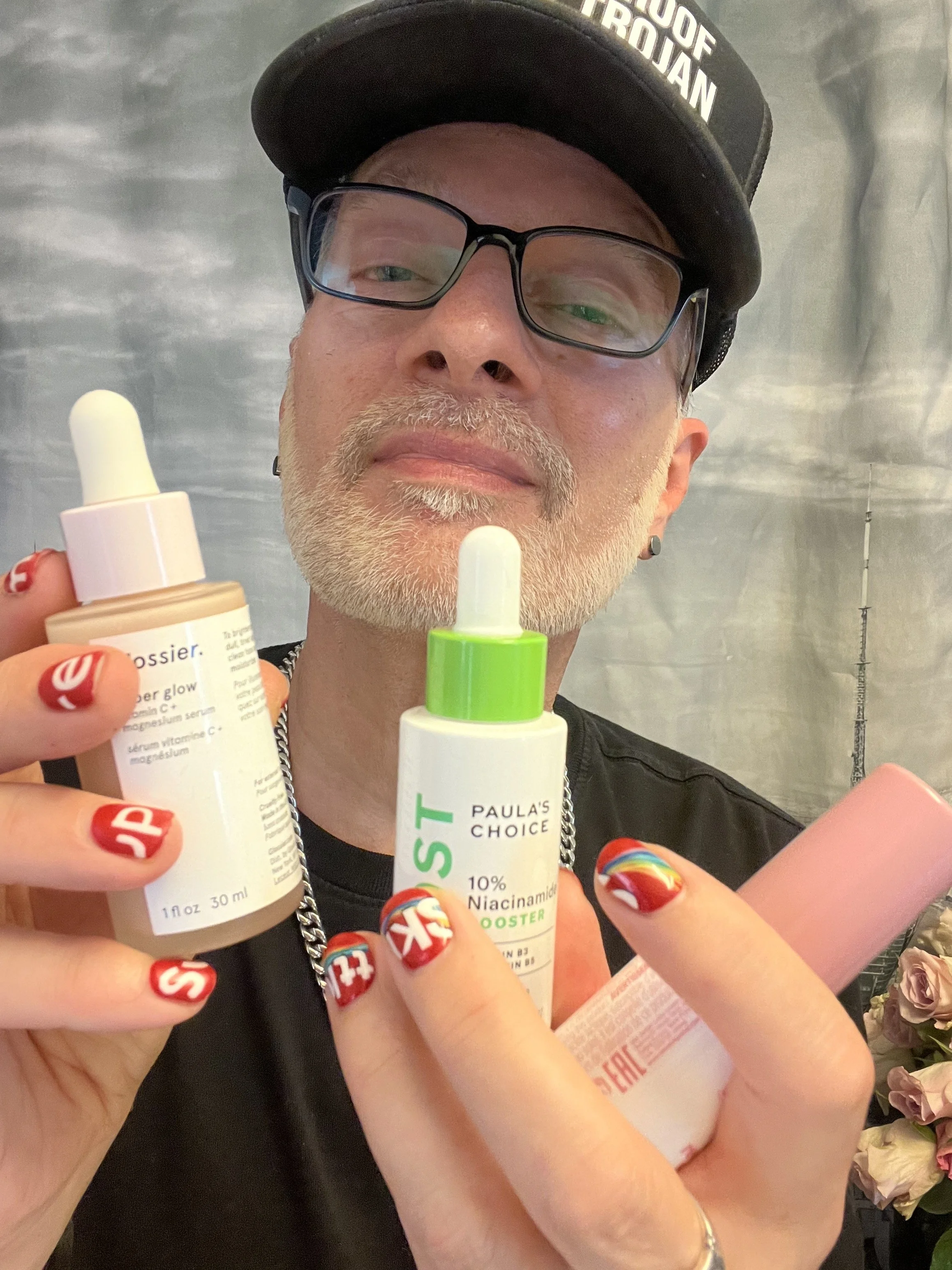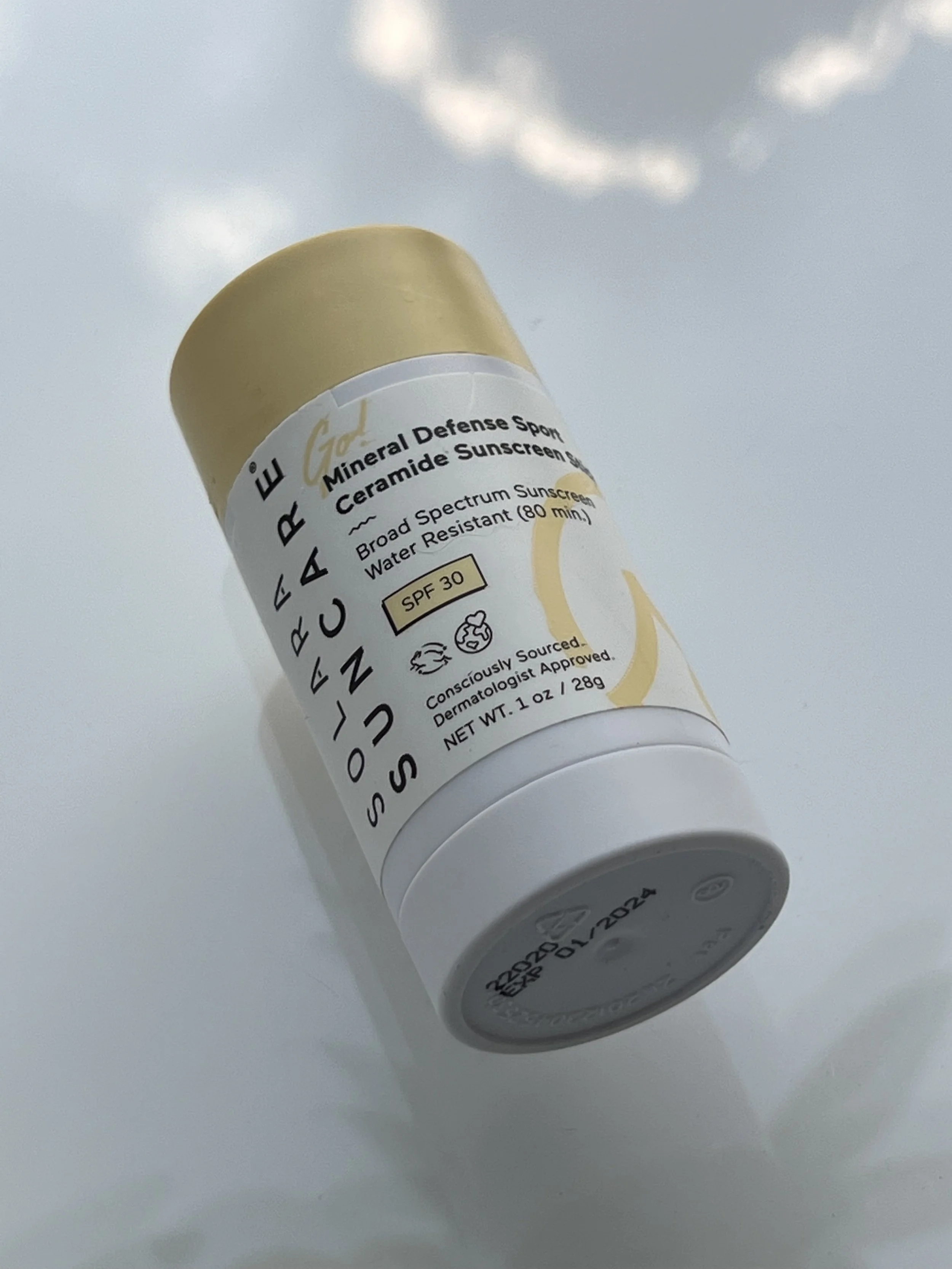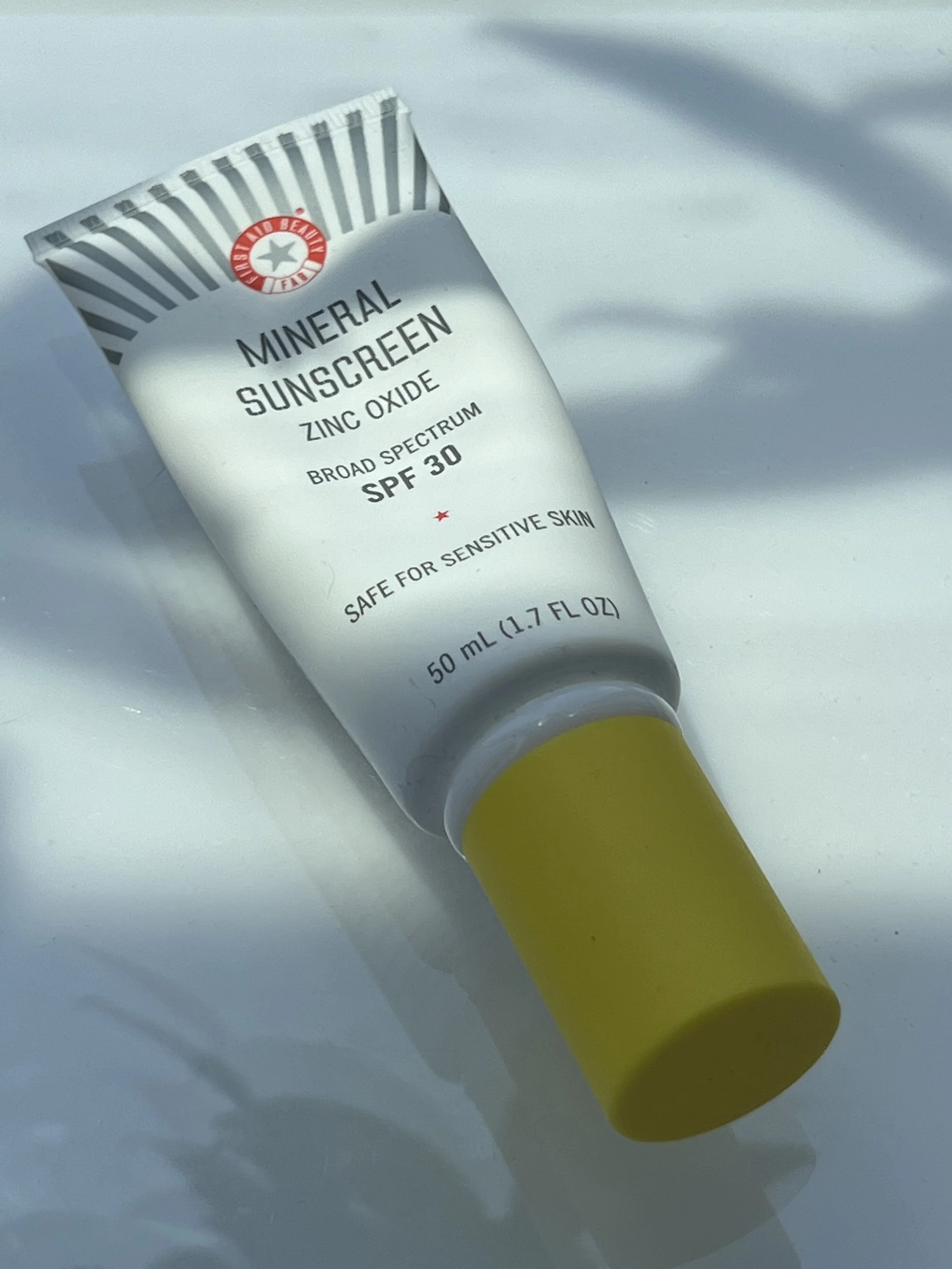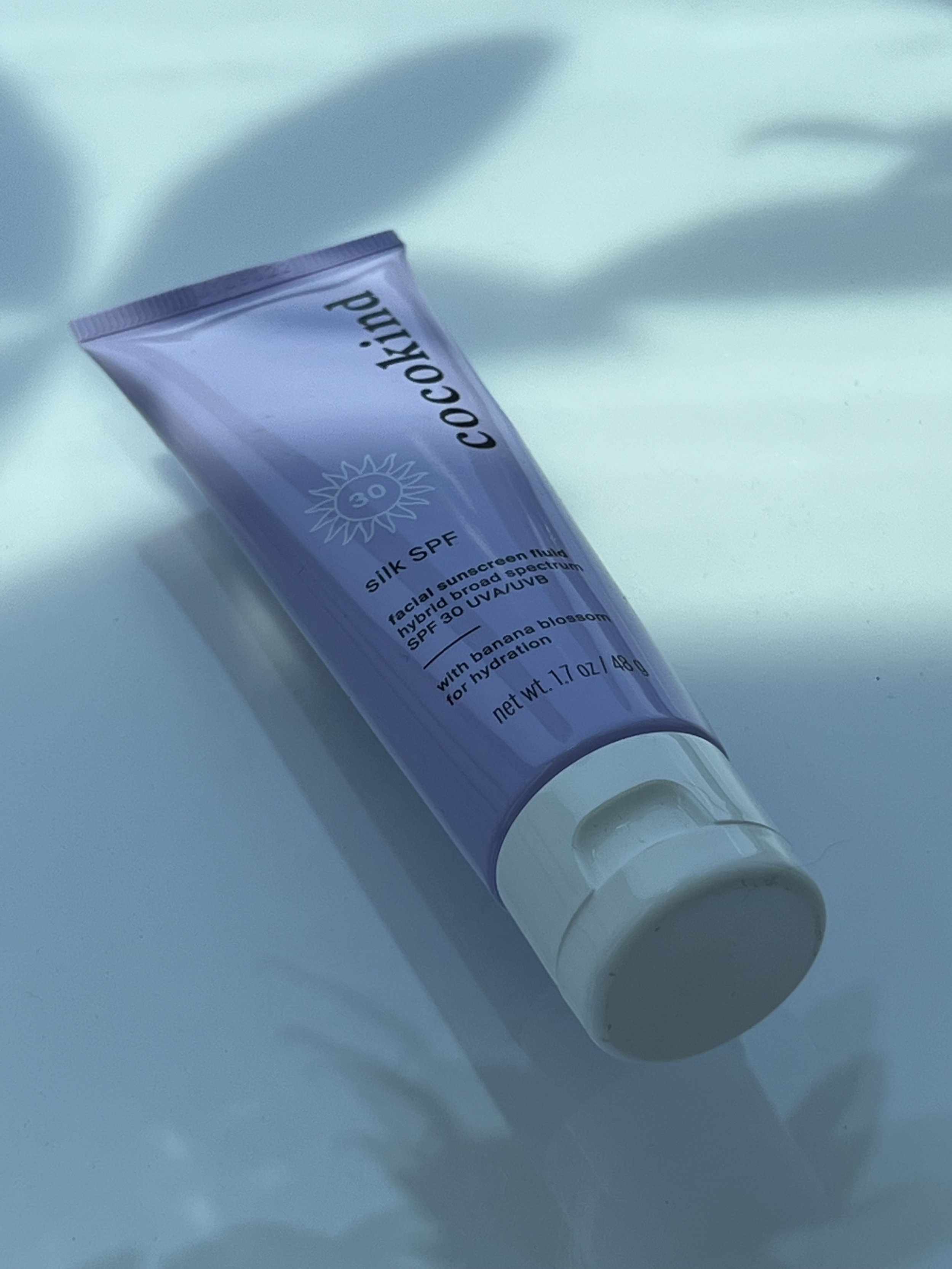NEW SUMMER SUNSCREENS I CAN’T PUT DOWN! COCOKIND SILK SPF, FIRST AID BEAUTY MINERAL SUNSCREEN, BLISS BLOCK PARTY - BEST LIGHTWEIGHT SUNSCREENS, BEST MINERAL SUNSCREEN WITH NO WHITE CAST
I’ve been having a lot of fun in the sun this summer. A few times this past week, I hopped on a Citi Bike and cruised around the City — to the bottom of Manhattan, across the Bronx and over the Brooklyn Bridge.
I caught the somewhat interesting Virgil Abloh “Freedom of Speech” exhibit at the Brooklyn Museum last weekend and enjoyed the Soul Summit concert in Fort Greene Park, across the street from me.
I couldn’t have been any luckier that my fave vegan restaurant, Greedi Kitchen, pulled up in a food truck to serve chickpea dumplings stuffed with Beyond Meat and peppers! Seriously, Greedi Kitchen is everything — with real vegan innovations and new things to try every time I swing by.
And, of course, as I do every other Friday, I hit the hottest nail art salon in all of New York, Vanity Projects NYC. Their team of Japanese nail artists is legendary. They take their craft to an almost incomprehensible level of creativity and can pretty much do anything you bring them.
This time, I was inspired by the graffiti I’ve whizzed past so often on my bike. My artist, Honami Ogawa (@hntsunail), really nailed it — no pun intended. If you’re into nail art and you’re in the City, you have to check out Vanity Projects!
My 2022 summer adventure is only just beginning…
The skincare stuff starts here.
I’ve been lucky to have both a ton of work and a ton of play this summer. And have even been able to get away for two long weekends so far — one to stay with good friends at their home in Sarasota, Florida; the other Upstate NY to a super relaxing retreat in the middle of nowhere.
I’ve taken the opportunity on both trips to take along new sunscreens – what are among the best sunscreens for face that I’ve come across this year. And while I believe you need to protect your skin from the damaging effects of the sun’s UV rays every day of the year, the sunscreen conversation always seems more relevant in the summer.
I get it. The sun is blazing in summer and we burn more easily, making sun damage more apparent and serving as reminder to wear sunscreen. But just because the effects of the sun’s burning UVB rays are more visible in summer doesn’t mean that the sun’s skin-aging UVA rays aren’t penetrating your skin barrier, damaging your DNA, and degrading your collagen all year-round.
As I like to say, if you can see the sun, the sun can see you.
Last week, I shared my top picks of tinted sunscreen for face in an article titled, Three Tinted Sunscreens I'm Obsessed with from Wander Beauty, Bliss and Solara Suncare. You can catch the piece here. Why tinted sunscreens? Well, I haven’t really played around with them much and have only really begun to appreciate their usefulness just this year.
THREE TINTED SUNSCREENS I'M OBSESSED WITH FROM WANDER BEAUTY, BLISS AND SOLARA SUNCARE - BEST TINTED SUNSCREENS
In the article, I featured the new Wander Beauty Pack Up & Glow Priming Broad Spectrum SPF 40 Mineral Sunscreen. With its super lightweight texture, the tinted mineral sunscreen is such a pleasure to use. I love the high level of mineral sun protection and ability to unify my skin tone without seeming like I applied anything but skincare. Psst…I love how it temporarily dyes my whiteish beard!
I also highlighted the Solara Suncare Go! Vacation Glow Illuminating Mineral Sunscreen — one of a handful of sunscreen products I took along with me on my trips to Upstate New York and Florida.
I’ve loved just about everything Solara Suncare has introduced and always expect really solid products from the brand. Vacation Glow is one of the more interesting sunscreens I’ve come across this year, with the qualities of a conventional BB Cream with SPF. Catch my product review of Vacation Glow Illuminating Mineral Sunscreen on the blog here.
The third in my tinted sunscreen collection was the Bliss Block Star Invisible Daily Sunscreen — perhaps the best mattifying sunscreen for oily skin I’ve come across. I’m wearing it as I write this and knew it would be perfect on one of the hottest, most humid days of the year! I’m so into it that I just had to include it among my favorite summer sunscreens in today’s blog. (I invite you to scroll down for the full review!)
As I’ve often said, a well-formulated sunscreen is one of very few true anti-aging products – something skincare marketers never claim in their advertising or their product messaging. There’s a whole billion dollar industry dedicated to over-hyped, over-priced “anti-aging” products — most of them ineffective and driven by big marketing dollars.
Millions are spent annually by big beauty conglomerates like Estee Lauder, Shiseido, Coty and L’Oreal to convince consumers to spend money on minimally effective skincare products that claim to be “anti-aging”. That’s why consumers shell out $200 for a one-ounce jar of Creme de la Mer, which when you look closely at the INCI is little more than Vaseline with seaweed in it.
THE SKINCARMA CHALLENGE: Vaseline vs. Creme de La Mer
What ingredients are best for anti-aging?
In addition to mineral and chemical sunscreen filters like Zinc Oxide, Titanium Oxide and Homosalate, antioxidant botanical extracts and antioxidant vitamins like Niacinamide, Retinol and Vitamin C deliver true, effective and clinically proven anti-aging benefits. Petroleum jelly and seaweed extract do not!
I know there is a lot of conversation around whether or not chemical sunscreens are okay for the skin and the body — and which is better, a chemical or mineral sunscreen. Honestly, whether your sunscreen is mineral, chemical or a hybrid matters little. What matters is that you find a sunscreen you love so much that you wouldn’t even think of skipping it in your morning skincare routine.
I look forward to applying a sunscreen as the last step of my morning routine. To me, it’s like the period at the end of a sentence. Make that an exclamation point!
The Best Sunscreens For Face
What’s the Difference Between Mineral and Chemical Sunscreens?
While I prefer a mineral sunscreen, it’s not a dealbreaker for me. What’s most important is that you love using your facial sunscreen product. If you love using a chemical sunscreen, that’s perfectly okay. One of my all-time favorite daily sunscreens for face is the Supergoop! Daily Dose Vitamin C + SPF 40 Sunscreen Serum PA+++ — a 100% chemical facial sunscreen that’s such a pleasure to use. As crazy as it sounds, I look forward to applying it! (You can catch my review of Daily Dose on the blog here.)
PRODUCT REVIEW: SUPERGOOP! ULTRA DAILY DOSE VITAMIN C + SPF 40 SUNSCREEN SERUM PA+++
What’s the difference between a mineral sunscreen and a chemical sunscreen – and is a mineral sunscreen better than a chemical sunscreen?
For helpful insights, there’s an excellent article by the experts on the Paula’s Choice Research Team titled, Mineral vs. Synthetic Sunscreen Ingredients. (It’s available here.) In the piece, the experts explain the differences and benefits between the two — and even dispel a myth or two.
The two types of sunscreen ingredients are mineral and synthetic [chemical], and both are equally protective. Further reassuring is that each can be included in formulas created for every skin type. For example, if you have normal to oily skin, there are weightless, non-greasy options; if you have normal to dry skin, it’s possible to find skin-smoothing, hydrating SPF products.
What’s the Difference Between Mineral and Synthetic Sunscreen Ingredients?
The differences aren’t about which type is more effective; rather, it comes down to personal preference and how sensitive your skin is—mineral sunscreens are considered the most gentle options.
Mineral sunscreens: There are only two mineral sunscreen ingredients: titanium dioxideand zinc oxide. They work in skin's uppermost layers to both absorb and, to a lesser extent, deflect and scatter the sun’s harmful rays. These mineral ingredients are sometimes referred to as physical sunscreens or physical blockers, although that’s not a factual representation of how they work.
Synthetic sunscreens: There are over 30 synthetic sunscreen ingredients, all of which absorb into the top layers of skin, where they work similar to mineral sunscreens: by scattering and deflecting the sun’s harmful rays, and by converting UV rays into heat and “deactivating” them. (Don’t worry, you won’t feel a thing.) Common synthetic sunscreen ingredients include oxybenzone, octinoxate, octisalate, and avobenzone. These are sometimes labeled “chemical sunscreens,” which is both misleading and false. All skin care ingredients, even water, are chemicals.
—
Which Sunscreen is Best?
As we said, the right sunscreen for you is the one you’ll look forward to applying daily. It should be rated SPF 30 or higher and provide broad-spectrum protection to prevent damage from the sun’s killer UVA and UVB rays. Beyond that, to make an informed choice, you need to know how your skin type responds to different sunscreen ingredients and textures: those containing mineral actives, synthetic actives, or a combination of both.
Mineral sunscreens:
Begin to work immediately on application, but must be absorbed to be most effective and to ensure they don’t wipe off on clothing.
Have almost no risk of irritating skin.
May leave a white cast, especially on darker skin tones, but the best pure mineral sunscreens go on almost sheer.
May need more careful, liberal application because of the way they work in formulas. So, go ahead, slather these on for brilliant protection!
Do not penetrate past skin's uppermost layers.
Synthetic sunscreens:
Begin to work immediately on application, but must be absorbed to be most effective and to ensure they don’t wipe off on clothing.
Are generally found in products with thinner textures.
Tend to be preferred for water-resistant formulas because they don’t turn milky-looking when you sweat or get wet. But, as with any sunscreen, you must reapply them often.
Can be sensitizing for those with extra-sensitive skin.
Can penetrate the skin and be absorbed in small amounts that are not shown to have health risks.
Read the full article here.
The Most Important Product You're (Probably) Not Using!
So yeah, I’ve been knee-deep in facial sunscreens over the last several weeks. Sure, I kicked off the season with product reviews of my top picks of tinted sunscreens for face. So I’m excited to share my picks of the best facial sunscreens for summer 2022.
The 2022 best summer sunscreens are: Cocokind’s Silk SPF Facial Sunscreen Fluid, the Bliss Block Star Invisible Daily Sunscreen and First Aid Beauty’s Mineral Sunscreen Zinc Oxide Broad Spectrum SPF 30.
The Cocokind Silk SPF Facial Sunscreen Fluid was only recently introduced by the brand. I was already a big fan of Cocokind’s first-ever sunscreen for face, the Daily SPF Mineral Sunscreen SPF 32 — a straight up mineral sunscreen with a 21% level of Zinc Oxide.
With its blend of moisturizing plant oils and humectants, the Daily SPF formula has such an elegant texture and is a real pleasure to use. And a sunscreen that’s a pleasure to use means you’re more likely to use it, right? Catch my review of Cocokind’s Daily SPF on the blog here.
PRODUCT REVIEW: COCOKIND DAILY SPF MINERAL SUNSCREEN SPF 32 - BEST MINERAL SUNSCREEN FOR FACE
The First Aid Beauty Mineral Sunscreen Zinc Oxide Broad Spectrum SPF 30 has truly been my go-to facial sunscreen this summer. When I’m not in the mood for a tinted one and just want a straight-up sunscreen product, that is! I love this un-fussy mineral facial sunscreen and, as with all of First Aid Beauty’s products, the non-irritating formula made for even the most sensitive skin.
And lastly is the Bliss Block Star Invisible Daily Sunscreen, which I reviewed last week and couldn’t resist including here among my picks of the best summer sunscreens. With its mattifying properties, it’s literally perfect for a hot, humid day.
I’m also including a favorite new sunscreen for the eye area, the Solara Suncare Go! Mineral Defense SPORT Ceramide Sunscreen Stick SPF 30. While it’s not necessarily marketed by the brand for use around the eyes, it really is perfect for just that. Find out why below!
Let’s have a look at each of my favorite sunscreens for summer 2022…
First Aid Beauty | Mineral Sunscreen Zinc Oxide Broad Spectrum SPF 30
I’ve been a big fan of First Aid Beauty for quite a while now. I’ve reviewed numerous First Aid Beauty facial skincare products on the blog over the years and have come to appreciate the brand for its range of some the best cleansers, serums and face creams for sensitive skin.
The brand’s moisturizers for sensitive skin run the full gamut with face creams for very oily skin to very dry skin — and all skin types in between. And since we’re dead smack in the middle of summer here in New York, I’m reminded of just how much I enjoyed First Aid Beauty’s Ultra Repair Oil-Control Moisturizer last year.
As I said about the Ultra Repair Oil-Control in my product review on the blog, the clean, oil-free formula is as light as air and feels virtually weightless on the skin — something I know people with oily skin can appreciate. Controlling surface oils is the main benefit of the Ultra Repair Oil-Control formula.
PRODUCT REVIEW: FIRST AID BEAUTY ULTRA REPAIR OIL-CONTROL MOISTURIZER – BEST FACE CREAM FOR OILY SKIN
FAB achieves the mattifying effect with a blend of mineral powders that absorb excess sebum on the surface of the skin, leaving a perfectly matte, natural-looking complexion. If you’re longing for a really great moisturizer for oily, sensitive skin, Ultra Repair Oil-Control is it.
About two years ago, the brand offered a wonderful tinted sunscreen fluid called Weightless Liquid Mineral SPF 30. Curiously, the product just vanished and I never understood why. I loved the stuff. I suspect it was too expensive at $34 for 1.5 oz. Or maybe it didn’t play well with makeup.
But it’s all good! First Aid Beauty, the brand with the best skincare for sensitive skin, just introduced an even better formulation in what has quickly become one of my favorite sunscreens ever. First Aid Beauty’s Mineral Sunscreen Zinc Oxide Broad Spectrum SPF 30 has a relatively sheer texture that blends quickly into my fairly light skin.
As the brand proudly declares on the front of the tube, the rather simply named Mineral Sunscreen is “safe for sensitive skin.” It’s a clean, non-toxic formula with just 18 ingredients in the entire INCI. I’ve even used it in my immediate eye area with nothing but effective sun protection.
That said, while it’s gentle enough for use around the eyes, it’s not necessarily intended or formulated for the eye area – and is likely to bleed into the eyes when sweating. Because of that, I prefer a thicker, putty-like sunscreen for eyes.
Psst…you can catch my picks of the best eye SPF on the blog here!
With 20% Zinc Oxide that delivers an effective SPF 30 protection, the First Aid Beauty Mineral Sunscreen leaves no white cast on the skin. I know there’s always conversation around whether you’re getting the best UV protection you can if you’re using a sunscreen with anything less that SPF 50 protection.
PRODUCT REVIEW: SKINCEUTICALS PHYSICAL EYE UV DEFENSE SPF 50 - BEST SPF FOR EYES AND DARK CIRCLES
The truth is, there’s a minimal difference in the level of UV protection between an SPF 30 and an SPF 50. SPF 30 blocks 97% of UVB rays, while an SPF 50 blocks 98% of UVB rays. The difference is one percent. I’m more concerned that friends, family and followers aren’t using a daily sunscreen at all – not that they’re using an SPF 30; which, again, offers superb protection on its own.
In addition to its mineral sun filter, the First Aid Beauty Mineral Sunscreen Zinc Oxide Broad Spectrum SPF 30 is loaded with pro-skin health actives, notably multiple replenishing non-fragrant plant oils that moisturize the skin. Among these are Caprylic/Capric Triglyceride, Avena Sativa (Oat) Kernel, Persea Gratissima (Avocado) Oil, and Helianthus Annuus (Sunflower) Seed Oil.
There’s also a solid level of humectant Glycerin in the formula at ingredient number four, which by my estimation is likely between 3% - 5%, a sufficient amount to prevent trans-epidermal water loss (TEWL), or dehydration. TEWL is a concern year-round, and in the summer heat, we literally sweat the water out of our skin through our pores. It’s summer, drink lots of water and apply lots of humectants!
What Is Trans-Epidermal Water Loss (TEWL)?
Trans-epidermal water loss, or TEWL, is the leading cause of dehydration — or insufficient water in the skin’s layers. Just as the body needs sufficient quantities of water each day to survive, the skin needs water to function in an optimally healthy manner. Dehydrated skin compromises skin barrier function, diminishing the skin’s ability to fortify itself against external aggressors.
For a deep-dive into trans-epidermal water loss, there’s an excellent article on the health website Skin Better titled, What Is Transepidermal Water Loss and Why Is it Important? It’s available to read here. In the piece, the author explains TEWL as follows:
“The skin is comprised of three primary layers: the epidermis, the outermost layer; the dermis or middle layer; and the hypodermis, the undermost layer. When water passes from the dermis through the epidermis and evaporates from the skin’s surface, this is known as transepidermal water loss (International Journal of Pharmaceutics).
While TEWL is a process that your skin naturally regulates, certain factors that can damage the skin’s barrier function can also affect TEWL levels. Circumstances such as injury, low-humidity weather conditions and topically applied products that dry out the skin can impact TEWL.
To achieve this, combine humectant and occlusive skincare ingredients.
Transepidermal water loss can contribute to a variety of dry skin conditions, and although it is a natural process, there are ways that you can help your skin stay moisturized and hydrated. Hydration refers to the water content of the skin, whereas moisturization is the skin’s ability to retain those water molecules. Therefore, your skin needs both elements to maintain desirable levels of TEWL.
To achieve this, combine humectant and occlusive skincare ingredients. Humectants help to draw moisture to the epidermis, either from the air if it is humid enough, or from the underlying dermis in low-humidity conditions. Because water content that is drawn from the dermis can be lost through TEWL, it’s important to combine the use of humectants with occlusives. Together, these ingredients create a reservoir of moisture in the epidermis and act as a barrier on the skin to help prevent TEWL by sealing in that moisture. The occlusive agents simultaneously keep pollutants, toxins and harmful bacteria out (Skin Therapy Letter).”
What I like about it: The First Aid Beauty Mineral Sunscreen Zinc Oxide Broad Spectrum SPF 30 is everything. With an ideal blend of replenishing plant oils and water-binding humectants, it leaves no white cast and is one of those sunscreens that’s such a pleasure to use you wouldn’t even think of skipping it. It’s my favorite sunscreen this summer!
What I don’t like about it: Honestly, I love everything about it.
Who it’s for: All skin types, except perhaps very oily and acne prone.
SHOP THE BLOG: Purchase the First Aid Beauty Mineral Sunscreen Zinc Oxide Broad Spectrum SPF 30 for $28 here.
SHOP THE BLOG
The Ingredient List of the First Aid Beauty Mineral Sunscreen Zinc Oxide Broad Spectrum SPF 30:
Zinc Oxide 20%, Water, Caprylic/Capric Triglyceride, Coconut Alkanes, Glycerin, Cetearyl Alcohol, Coco-Glucoside, Avena Sativa (Oat) Kernel, Tocopherol, Persea Gratissima (Avocado) Oil, Helianthus Annuus (Sunflower) Seed Oil, Arachidyl Alcohol, Behenyl Alcohol, Arachidyl Glucoside, Polyhydroxystearic Acid, Benzyl Alcohol, Xanthan Gum, Coco-Caprylate/Caprate.
Cocokind | Silk SPF Facial Sunscreen Fluid
I was first introduced to Cocokind about a year ago and have loved literally everything that’s come my way. Cocokind’s first sunscreen for face, the Daily SPF Mineral Sunscreen SPF 32, was a personal favorite on my trip to Cabo back in February at the start of the year. I featured it in a blog article titled, Three Amazing Sunscreens I Took with Me to Cabo From Supergoop, Cocokind And Cosrx. (You can catch it here.)
The Daily SPF Mineral Sunscreen SPF 32 is a straight-up mineral sunscreen with a 21% level of Zinc Oxide. It’s a bit on the thick side, which meant that it was ideal for my skin during the colder months. It feels too heavy for me in the summer. And while it leaves no white cast on my light skin, it is likely to on darker skin tones.
THREE AMAZING SUNSCREENS I TOOK WITH ME TO CABO FROM SUPERGOOP, COCOKIND AND COSRX - BEST SUNSCREENS FOR FACE
I can only imagine the conversation around the table at the Cocokind offices. Everyone loves the Daily SPF, but we know it’s going to be too thick for most people when the weather heats up. Who’s gonna want to use it in the summer?
And they’d be right. So it makes complete sense to me that Cocokind would come out with something much lighter and much more comfortable on a hot, humid day. The Cocokind Silk SPF Facial Sunscreen Fluid is just right! Introduced only a few weeks ago at the start of the summer season, the Silk SPF Facial Sunscreen Fluid is super lightweight with, as the name indicates, a more fluid texture.
While it’s got fluid in the name, don’t be misled into thinking it’s as light as the iconic Skin Aqua Super Moisture Milk – the cult Japanese sunscreen that I often joke may be made from alien technology. There’s literally nothing as light as that one. Of course, it’s likely really hot on that alien planet.
PRODUCT REVIEW: SKIN AQUA SUPER MOISTURE MILK SPF 50 – ONE OF THE BEST SUNSCREENS FOR OILY SKIN
No matter, Cocokind’s Silk SPF Facial Sunscreen Fluid is light enough for most of us on a summer day — and ideal for oily skin year-round. It’s what’s termed a hybrid sunscreen; that is, one which is formulated with both chemical and mineral sun filters. In the case of Silk SPF, there’s 10.5% Zinc Oxide and 10% Homosalate for solid SPF 30 broad-spectrum protection against UV damage.
And, unlike the brand’s Daily SPF, there are relatively few plant oils in the formula – with only Caprylic/Capric Triglyceride appearing in the INCI. A common alternative to mineral oil and silicone in skincare, it’s an oily, fatty alcohol derived from palm kernel or coconut oil.
Also listed as Coco-caprylate, according to the experts on the Paula’s Choice Research Team the fatty alcohol “is the mixture of esters that occur when the fatty alcohols derived from coconut alcohol reacts with the fatty acid caprylic acid.” I love science!
While it’s light on moisturizers, Cocokind’s Silk SPF Facial Sunscreen Fluid is heavy on hydrators, making it ideal for summer. The most notable hydrating humectant in the formula is Glycerin, which is really experiencing its time in the sun. Suddenly, Glycerin is everywhere! And I love that.
Glycerin has been used in skincare for a million years. As such, it’s not the sexiest, coolest, or most exciting ingredient. And skincare marketers rarely call it out because “everyone uses it.” So what! It’s effective, inexpensive and feels great on the skin. In fact, I’m guilty of not paying enough attention to it myself.
Truthfully, there are only a handful of humectants as effective as Glycerin. Among the best humectants in skincare are Hyaluronic Acid, honey, aloe, Snow Mushroom Extract, Beta-Glucan and tried-and-true Glycerin.
I found a really interesting article on humectants titled, The Best Humectants to Use in Natural Skincare. You can catch it here if you’re interested.
What Is Glycerin and Is Glycerin the Same as Hyaluronic Acid?
According to the experts on the Paula’s Choice Research Team, Glycerin is one of the best ingredients used in skincare and among the best water-binding humectants for preventing dehydrating trans-epidermal water loss, or TEWL. Because it’s so effective, Glycerin is considered as good a humectant as Hyaluronic Acid.
Glycerin, also called glycerol or glycerine, is a humectant that’s present in all natural lipids (fats), whether animal or vegetable. It can be derived from natural substances by hydrolysis of fats and by fermentation of sugars; it also can be synthetically manufactured, which is usually the case with modern-day skin care products, as doing so results in highly purified glycerin.
Glycerin is a skin-replenishing and skin-restoring ingredient, meaning it is a substance found naturally in skin, helping to establish normal balance and hydration. It’s one of the many substances in skin that helps maintain a healthy look and feel, defending against dryness and working to maintain skin’s moisture level. Essentially, glycerin is a master at hydration, and works best when combined with other replenishing and emollient ingredients.
Some people wonder whether using products with glycerin takes too much water from skin when there isn’t enough humidity in the air. This can occur with pure glycerin (that is, at a 100% concentration - an amount that’s never used in skin care products). Any humectant (including glycerin) used in pure form can increase water loss by attracting water from the lower layers of skin into the surface layers when the climate is too arid (low humidity). For this reason, glycerin and humectants are typically used in concentrations of 5% or less and always combined with other ingredients to soften skin. In fact, glycerin combined with other emollients and/or oils is a fundamental cornerstone of most moisturizers. However, amounts of 10% or greater can be used in clinical circumstances for skin healing.
What I like about it: The Cocokind Silk SPF Facial Sunscreen Fluid is the perfect balance of texture and efficacy in a summer sunscreen. It’s super lightweight and supremely hydrating. It’s an absolute pleasure to use and the ideal alternative to the brand’s heavier 100% mineral sunscreen, Daily SPF.
What I don’t like about it: It’s pretty much perfect.
Who it’s for: All skin types, even very oily and acne prone.
SHOP THE BLOG: Purchase the Cocokind Silk SPF Facial Sunscreen Fluid for $25 here.
The Ingredient List of the Cocokind Silk SPF Facial Sunscreen Fluid:
Zinc Oxide 10.5%, Homosalate 10%
water/aqua/eau, caprylic/capric triglyceride, glyceryl stearate se, coconut alkanes, glycerin, coco-caprylate/caprate, decyl glucoside, oryza sativa (rice) starch, musa sapientum (banana) flower extract, polyhydroxystearic acid, polyglyceryl-3 polyricinoleate, isostearic acid, lecithin, xanthan gum, hydroxyethylcellulose, caprylyl glycol, caprylhydroxamic acid, sodium benzoate, citric acid, disodium phosphate, sodium phosphate.
SHOP THE BLOG
Bliss | Block Star Invisible Daily Sunscreen
It’s been so long since I experienced a single product from Bliss that I can’t even recall when the last time I tried the brand was. I remember there was this iconic Lemon & Sage Body Butter that a good friend was infatuated with. That had to be 15-20 years ago. Interestingly, even though Bliss has gone through a major rebrand, the Lemon & Sage Body Butter is still around. (In fact, I just text him and he says he still uses it!)
But I haven’t personally been a Bliss fan, though I have followed the classic skincare brand as it was rebranded and repositioned to target a younger, Gen Z consumer. That’s sure not me!
So I’m eager to experience Bliss anew! And I’m happy to say that the Bliss Block Star Invisible Daily Sunscreen 100% mineral SPF for face is quite a solid formula. I really love the stuff. The most distinguishing factors in comparison to the other sunscreens reviewed in today’s blog? Block Star has a mattifying effect and a skin-perfecting tint.
While I love a healthy glow as much as anyone, in the dog days of summer when heat and humidity are on full blast, the last thing I need or want is skincare that makes me glow even more! Standing on the subway platform waiting for the train in the middle of August is one of the most unpleasant experiences of every New Yorker. The air is stale and rancid. The heat is excruciating. And your face is a greasy mess.
So the Bliss Block Star Invisible Daily Sunscreen couldn’t have come at a better time. This summer, I like to think I’m grease-proofed!
Block Star is a 100% mineral sunscreen with 4.1% Titanium Dioxide and 11.5% Zinc Oxide for a solid SPF 30 coverage. Don’t be fooled by the whole “you gotta have an SPF 50 to really protect yourself from sun damage thing.” The difference in UV defense between SPF 30 and SPF 50 is negligible – just one percent.
No Skincarma Blog review about sunscreen products and the importance of sun protection would be complete without mention of Jeanne and Susan, identical twin sisters.
Seriously, I can’t imagine a Skincarma Blog article about the best facial sunscreen products for the summer heat without an introduction to my friends Jeanne and Susan — identical twin sisters.
No, they're not my actual friends; in fact, we’ve never met. But I feel like I know them. As good friends would, they inspire me to be better — and to wear sunscreen every single day of the year. If you need proof of the very real effects of sun damage on your skin, look no further than these two ladies.
The sisters looked exactly alike growing up. But Susan has spent her life in Florida worshiping the sun (she’s also a heavy smoker!) while sister Jeanne lives in Ohio and has generally avoided overexposure to the sun (and smoking) throughout her life. While both were 61 when the adjacent photo was taken, a scientific study of Susan’s skin at Case Western Reserve University showed an 11-year age difference — Susan has extreme hyperpigmentation (sun spots), deeper wrinkles and degradation in skin elasticity.
Be a Jeanne, not a Susan!
While the Bliss Block Star Invisible Daily Sunscreen doesn’t contain the robust antioxidant defense of Solara Suncare’s Go! Vacation Glow Illuminating Mineral Sunscreen, it does contain a similar blend of antioxidant botanicals. They’re just not in the top ten of the INCI.
Much of the Block Star formula’s top ten is the two mineral sun filters and multiple forms of silicone. That’s not a deal-breaker for me, but I know a lot of people prefer to avoid them in their skincare. They do a lot to enhance the formula’s texture, but don’t have much of a benefit for the skin beyond preventing dehydration.
As I like to say, what’s important is that you find a daily facial sunscreen that you love so much you look forward to applying it. The Block Star is clean, full of pro-skin health actives, and has solid mineral sunscreen protection. All that makes it a winner for me!
I love its matte finish and appreciate the smattering of replenishing plant oils like Squalane, Anthemis Nobilis (Chamomile) Flower Oil and Rosa Canina (Rose Hip) Fruit Oil — one of the best anti-aging face oils. Regrettably, none of these beneficial oils, as with the antioxidant extracts in the formula, is at a significant level. Let’s say they’re nice to have but don’t have enough oomph to be truly effective.
What I like about it: The Bliss Block Star Invisible Daily Sunscreen is a terrific mineral sunscreen for face with a mattifying effect that I really love. At just $25, it’s well-formulated for the price.
What I don’t like about it: The level of antioxidant extracts in the formula isn’t sufficient to meet my expectations for antioxidant protection. And, the concentration of replenishing plant oils is too low to do much replenishing.
Who it’s for: All skin types, especially oily skin.
SHOP THE BLOG: Purchase the Bliss Block Star Invisible Daily Sunscreen for $25 here.
The Ingredient List of the Bliss Block Star Invisible Daily Sunscreen:
 sii|h 0 0, Dicaprylyl Carbonate emo, Propylene Glycol Dicaprylate emo|vc, Disiloxane, Dimethicone/Vinyl Dimethicone Crosspolymer vc, Dimethicone emo 0 1, PEG-10 Dimethicone emu, Sodium Acrylates Crosspolymer-2, Polymethylsilsesquioxane, Butyloctyl Salicylate solv, Vinyl Dimethicone/Methicone Silsesquioxane Crosspolymer vc, Vaccinium Angustifolium(Blueberry) Fruit Extract so, Oenothera Biennis (Evening Primrose) Flower Extract, Euterpe Oleracea Fruit Extract, Hibiscus Sabdariffa Flower Extract, Camellia Sinensis Leaf Extract
sii|h 0 0, Dicaprylyl Carbonate emo, Propylene Glycol Dicaprylate emo|vc, Disiloxane, Dimethicone/Vinyl Dimethicone Crosspolymer vc, Dimethicone emo 0 1, PEG-10 Dimethicone emu, Sodium Acrylates Crosspolymer-2, Polymethylsilsesquioxane, Butyloctyl Salicylate solv, Vinyl Dimethicone/Methicone Silsesquioxane Crosspolymer vc, Vaccinium Angustifolium(Blueberry) Fruit Extract so, Oenothera Biennis (Evening Primrose) Flower Extract, Euterpe Oleracea Fruit Extract, Hibiscus Sabdariffa Flower Extract, Camellia Sinensis Leaf Extract  aox|so, Pinus Palustris Leaf Extract, Ulmus Davidiana Root Extract
aox|so, Pinus Palustris Leaf Extract, Ulmus Davidiana Root Extract  h, Pueraria Lobata Root Extract h, Enantia Chlorantha Bark Extract, Lavandula Angustifolia (Lavender) Oil
h, Pueraria Lobata Root Extract h, Enantia Chlorantha Bark Extract, Lavandula Angustifolia (Lavender) Oil  amic|perf, Rosa Canina Fruit Oil emo, Anthemis Nobilis Flower Oil
amic|perf, Rosa Canina Fruit Oil emo, Anthemis Nobilis Flower Oil  so|perf, Sodium Hyaluronate
so|perf, Sodium Hyaluronate  sii|h 0 0, Oleanolic Acid, Squalane
sii|h 0 0, Oleanolic Acid, Squalane  sii|emo 0 1, Glyceryl Caprylate pres, Aluminum Hydroxide emo|h|vc, Polyglyceryl-6 Polyricinoleate emu, Sorbitan Caprylate emu, Stearic Acid emo|vc 0 2-3, Synthetic Fluorphlogopite vc, Triethoxycaprylylsilane, Dipropylene Glycol solv, 1,2-Hexanediol solv, Dimethicone/PEG-10/15 Crosspolymer emu, Disteardimonium Hectorite vc, Magnesium Sulfate vc, Ethylhexylglycerin pres, Iron Oxides col 0 0
sii|emo 0 1, Glyceryl Caprylate pres, Aluminum Hydroxide emo|h|vc, Polyglyceryl-6 Polyricinoleate emu, Sorbitan Caprylate emu, Stearic Acid emo|vc 0 2-3, Synthetic Fluorphlogopite vc, Triethoxycaprylylsilane, Dipropylene Glycol solv, 1,2-Hexanediol solv, Dimethicone/PEG-10/15 Crosspolymer emu, Disteardimonium Hectorite vc, Magnesium Sulfate vc, Ethylhexylglycerin pres, Iron Oxides col 0 0Solara Suncare | Go! Mineral Defense SPORT Ceramide Sunscreen Stick SPF 30
Solara Suncare’s Time Traveler Ageless Daily Face Sunscreen SPF 30 is one of my all-time favorite sunscreens for face. I first featured Time Traveler in a blog article on what I referred to at the time as my dream skincare routine titled, A Complete $175 Clean Skincare Routine with Herbivore, The Inkey List, Solara Suncare & More! That was more than three years ago!
I love the Solara Suncare brand — and the incredibly functional, well-formulated sunscreens that the brand’s founder, Stephanie DiPisa, has created. With clean formulas and elegant textures, the brand is reminiscent of the leader in sunscreen products for face and body, Supergoop!
So it was no surprise to me that the new Solara Suncare Go! Vacation Glow Illuminating Mineral Sunscreen reviewed in last week’s blog would be so exceptional and be among my top picks of tinted sunscreens.
PRODUCT REVIEW: SOLARA SUNCARE GO! VACATION GLOW ILLUMINATING MINERAL SUNSCREEN
As I said in my review, Solara’s Go! Vacation Glow reminds me of a BB cream with SPF. The new Vacation Glow is much, much more than a facial sunscreen. It’s infused with multiple pro-skin health ingredients at relatively active levels. The INCI’s top ten is loaded with water-binding humectants and two solid antioxidant botanicals, including Acai Fruit Extract, and tried-and-true Green Tea Leaf Extract — one of the best antioxidant ingredients in skincare.
Antioxidants are anti-aging and as essential to skin health as sunscreen actives like Zinc Oxide. Both should be key components in an effective daily anti-aging routine.
What’s the first place on the face to show signs of aging? The eye area! And the reason why we develop fine lines and wrinkles around the eyes before anywhere else on the face is two-fold: the skin around the eyes is thinnest and most of us make the mistake of not using sunscreen in the immediate eye area. That’s a double whammy!
The Best Sunscreens For Eyes
So I’m always on the hunt for great eye SPF products. Among my long-time favorites are the SkinCeuticals Physical Eye UV Defense SPF 50 and the MDSolarSciences Mineral Tinted Sunscreen Stick SPF 30. Both are ideal for the eye area with thick formula textures that stay put and don’t bleed into the eyes – the main reason people don’t wear sunscreen in the eye area.
I get it. It burns!
But the solution isn’t and can’t be not using sunscreen around the eyes. The solution is to find an eye area sunscreen that doesn’t migrate into the eyes. The Solara Suncare Go! Mineral Defense SPORT Ceramide Sunscreen Stick SPF 30 is the perfect option.
While the Mineral Defense SPORT Ceramide Sunscreen Stick isn’t marketed by the brand as an SPF for the eye area, it’s kind of the whole package — accidentally. The super wide, rounded stick first perfectly inside the orbital bone for an easy, comfortable application.
With 20% non-nano Zinc Oxide, Solara’s Mineral Defense SPORT Ceramide Sunscreen Stick offers SPF 30 protection for the delicate skin around the eyes. Is SPF 30 enough? Yes, it is. It’s a common misperception that you’re not doing enough to protect your skin, whether around your eyes or over your entire face, with anything less than an SPF 50.
The truth is, there’s a minimal difference between the level of UVB rays blocked by SPF 30 and SPF 50. It’s literally something like one percent. (Of course, anything is a step up from not using sunscreen at all!)
In addition to its mineral sun filter, the Solara Suncare Mineral Defense SPORT Ceramide Sunscreen Stick is infused with multiple pro-skin health actives which moisturize and replenish the thinner skin around the eyes. Thinner skin also retains water less effectively, meaning dehydration is a more serious concern in the eye area. Hence, the appearance of “fine dehydration lines” around the eyes.
The Best Summer Sunscreen for Eyes!
What’s the percentage of UV rays blocked by sunscreen?
SPF 15 blocks 93% of UVB rays
SPF 30 blocks 97% of UVB rays
SPF 50 blocks 98% of UVB rays.
So, the difference in UV rays blocked by SPF 30 and SPF 50 is about 1 percent.
The first ingredient after Zinc Oxide in the INCI is Coco-caprylate, which according to the experts in the Paula’s Choice Research Team “is the mixture of esters that occur when the fatty alcohols derived from coconut alcohol reacts with the fatty acid caprylic acid.” Also in the top five are moisturizing Jojoba Esters, Jojoba Seed Oil, and Sunflower Seed Oil.
With two waxes, the sun stick has a firmer, denser texture that adheres to the skin and stays put after application so it never bleeds into the eyes — unless you rub it! And, perhaps my favorite characteristic is its slightly iridescent hue that helps to brighten the look of dark circles under the eyes.
The one drawback to the formula is the inclusion of a tiny amount of fragrant plant oils in the form of Tangerine Oil and Orange Oil. It smells great, but if you have an extreme sensitivity to fragrance and essential oils, I’d skip it.
Me? I’m literally obsessed with it!
What I like about it: The Solara Suncare Go! Mineral Defense SPORT Ceramide Sunscreen Stick SPF 30 is my favorite new eye cream with SPF. While it’s not marketed for the eye area, it’s literally perfect. The rounded applicator fits perfectly inside the orbital bone. It’s loaded with pro-skin health actives and its slightly iridescent hue is ideal for brightening dark circles. What a dream!
What I don’t like about it: Again, it’s not marketed for the eye area, so I’d like to see the citrus oils removed. But they’re at a very low level and shouldn’t cause any irritation. I haven’t seen any myself.
Who it’s for: All skin types, except those who are super sensitive to fragrant plant oils.
SHOP THE BLOG: Purchase the Solara Suncare Go! Mineral Defense SPORT Ceramide Sunscreen Stick SPF 30 for $16 here.
That’s it guys! Thanks for checking in on the Skincarma Blog! And I hope you discover a sunscreen you love so much this summer you look forward to applying it each morning. That’s the best (and smartest!) thing you can do to combat signs of skin aging.
For my top picks of the best sunscreens for face, check out the blog here.
See you next week…
💟 Carmine @skincarma
SHOP THE BLOG
The Ingredient List of the Solara Suncare Go! Mineral Defense SPORT Ceramide Sunscreen Stick SPF 30:
Active: Non-Nano Zinc Oxide, 20%
Inactive: Coco-Caprylate, Beeswax/Cera Alba*, Jojoba Esters, Simmondsia Chinensis (Jojoba) Seed Oil, Helianthus Annus (Sunflower) Seed Oil, Euphorbia Cerifera (Candelilla) Wax, Lauryl Laurate, Caprylic/Capric Triglyceride, Methyl Dihydroabietate, Stearyl/Octyldodecyl Citrate Crosspolymer, Citrus Reticulata (Tangerine) Peel Oil, Isostearic Acid, Lecithin, Polyglyceryl-3 Polyricinoleate, Mangifera Indica (Mango) Seed Butter, Ceramide NG, Ceramide NP, Theobroma Cacao (Cocoa) Seed Butter, Citrus Aurantium Dulcis Peel Oil, Glycine Soja (Soybean) Seed Extract, Silica, Glyceryl Caprylate, Glyceryl Undecylenate, Tocopherol
WATCH MY VIDEO REVIEW OF
COOL CLEAN FACIAL SUNSCREENS TO KEEP US SAFE AND SMILING IN THE SUN
ON MY YOUTUBE CHANNEL HERE
WATCH MY VIDEO REVIEW
THE BEST NIACINAMIDE SERUMS FOR CLOGGED PORES AND A BRIGHTER COMPLEXION
ON MY YOUTUBE CHANNEL HERE
WATCH MY VIDEO REVIEW
THE SKINCARMA PRODUCT OF THE YEAR: BALM LABS 3-STEP REGIMEN - BEST ACNE REGIMEN, BEST CBD SERUM
ON MY YOUTUBE CHANNEL HERE
WATCH MY VIDEO REVIEW OF
SKINCARE HACKS: GLYCOLIC ACID IS THE NATURAL DEODORANT THAT WORKS!
ON MY YOUTUBE CHANNEL HERE
WATCH MY VIDEO REVIEW
COOL CLEAN FACIAL SUNSCREENS TO KEEP US SAFE AND SMILING IN THE SUN!
ON MY YOUTUBE CHANNEL HERE
WATCH MY VIDEO REVIEW
THE YEAR’S BEST VITAMIN C SERUMS WITH PAULA'S CHOICE, SUNDAY RILEY, THE INKEY LIST AND MORE!
ON MY YOUTUBE CHANNEL HERE
WATCH MY VIDEO REVIEW
THE BEST HYALURONIC ACID SERUMS FROM PAULA'S CHOICE, THE INKEY LIST, GHOST DEMOCRACY & MORE
ON MY YOUTUBE CHANNEL HERE
WATCH MY VIDEO REVIEW OF
A SELFCARE SUNDAY NOT FOR THE FAINT OF HEART – WITH THE PAULA’S CHOICE 25% AHA PEEL!
ON MY YOUTUBE CHANNEL HERE
WATCH MY VIDEO REVIEW
MY 2021 VITAMIN C PICKS + THE BEST VITAMIN C SERUMS TO BRIGHTEN UP THE COMPLEXION!
ON MY YOUTUBE CHANNEL HERE


